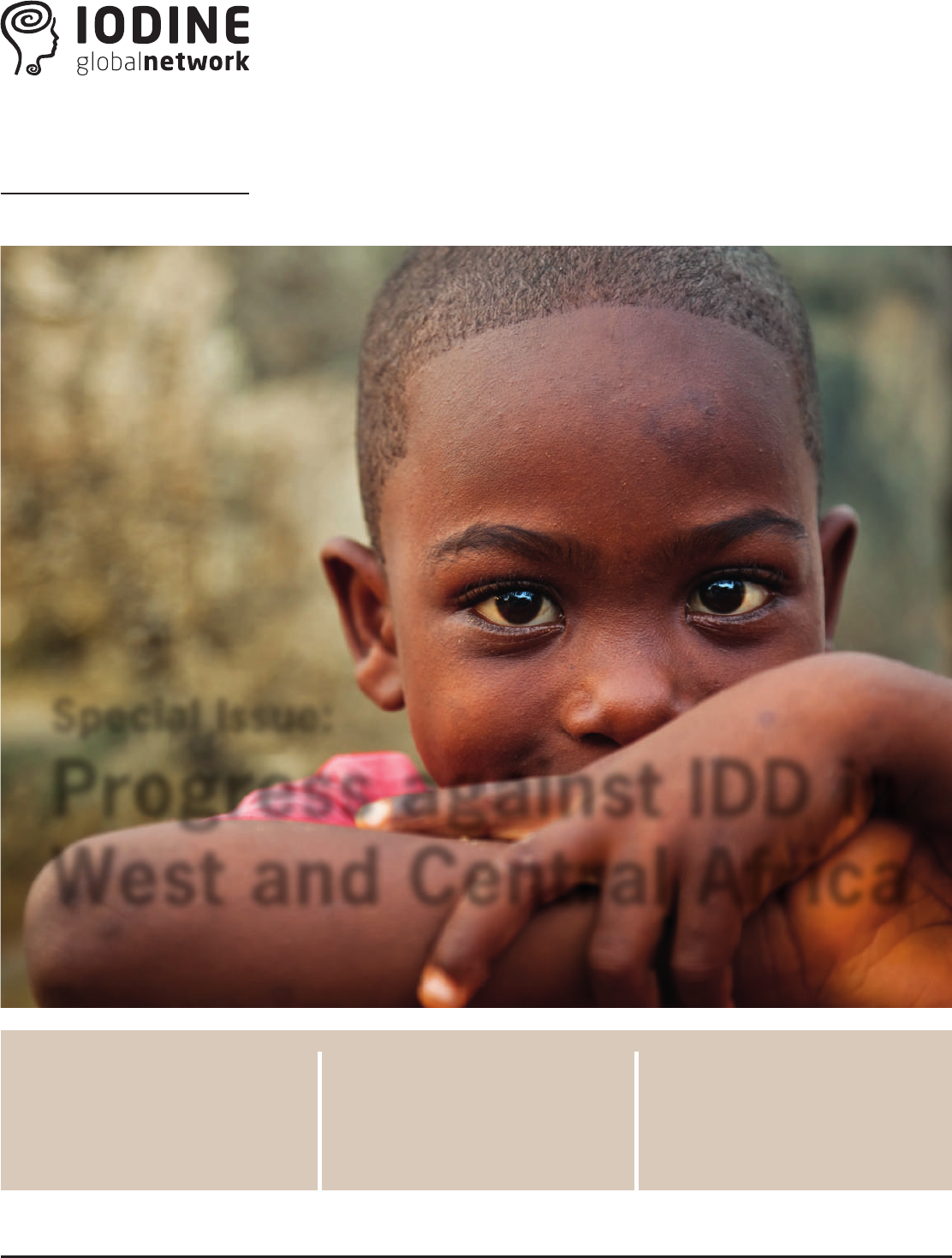
IODINE GLOBAL NETWORK is a nongovernmental organization dedicated to sustained optimal iodine nutrition and
the elimination of iodine deficiency throughout the world.
Special Issue:
Progress against IDD in
West and Central Africa
IDD
NEWSLETTER
Iodized salt in
Mauritania
PAGE 7
West and Central
African salt trade
PAGE 10
Nigerian salt chain
analysis
PAGE 16
VOLUME 50
NUMBER 2
MAY 2022
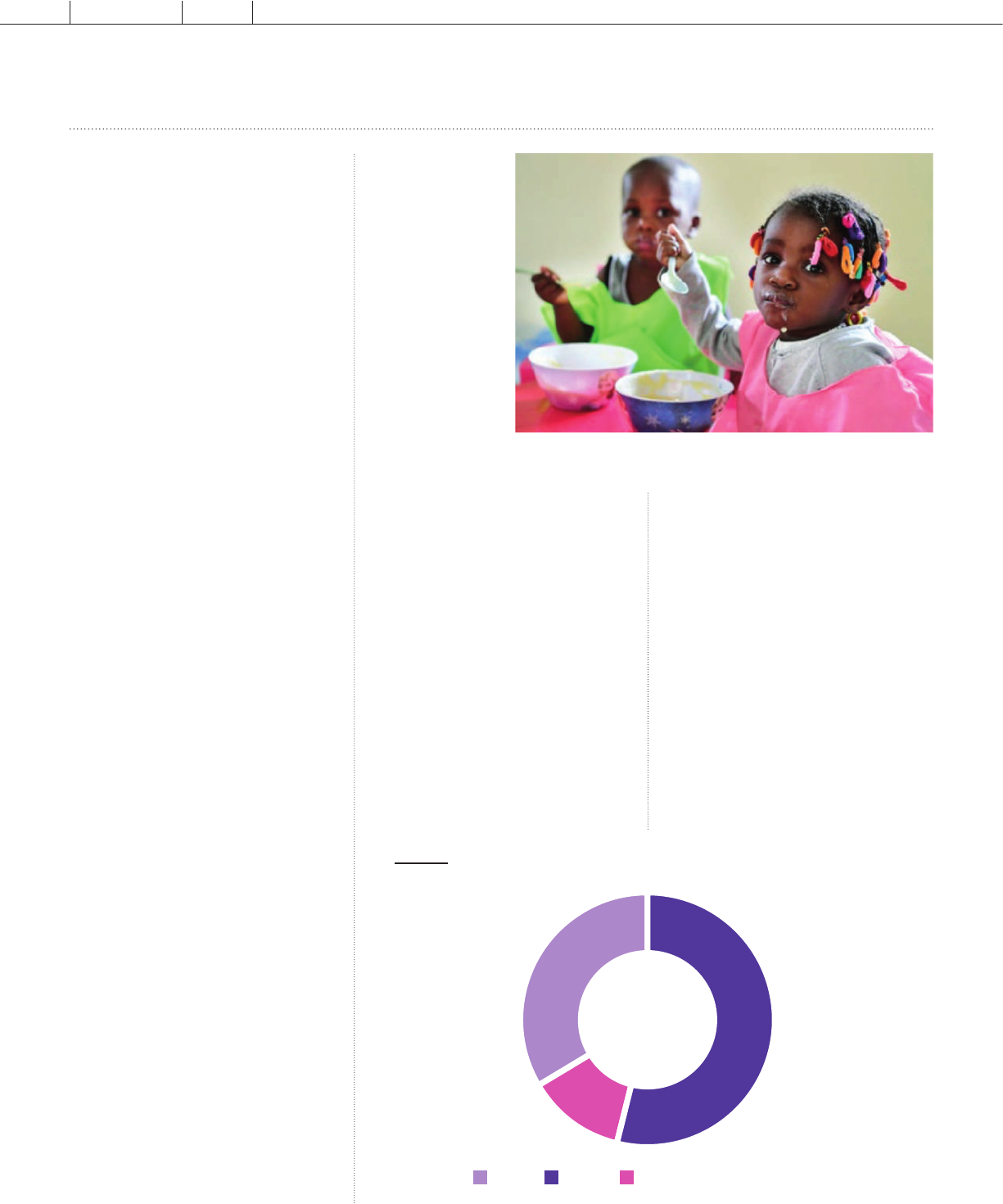
2
IDD NEWSLETTER MAY 2022 IDD IN WCA
To contribute to the sustainable eliminati-
on of iodine deficiency disorders in West
and Central Africa, the United Nations
Children’s Fund (UNICEF) and the Iodine
Global Network (IGN) formed a part-
nership to support national and regional
efforts to scale up and sustain universal salt
iodization (USI). One initiative involved
carrying out a landscape analysis to develop
a common understanding of the situation
and of the bottlenecks at national and regi-
onal levels. In this special IDD Newsletter
edition focusing on the iodine program-
ming in West and Central Africa, some of
the findings from this analysis are presented
in a series of articles.
UNICEF's West and Central Africa
(WCA) region encompasses 24 countries
that spread across semi-arid areas in the
Sahel, large coastal areas on the Atlantic
Ocean and along the Gulf of Guinea inclu-
ding a few islands, as well as tropical forests
covering many countries (1). The region
is defined by diverse economic, social,
cultural, demographic, and geographical
characteristics. It uses four official languages
(English, French, Spanish and Portuguese),
with over a thousand local languages. In
2018, the regional population was 520
million, and the population growth for
the next 10 years was estimated at 2.6%
compared to 0.9% for the rest of the
world. With 12% of its population being
under the age of 15, WCA has one of the
youngest populations in the world (1).
The region is also experiencing accelerated
urbanisation, with urban centres hosting
48% of the population (2) and, due to the
high level of violence and political tension,
there are over 11.9 million people who are
either internally displaced persons (IDPs),
refugees, asylum-seekers or stateless (3).
Regional trends in iodine status
and access to iodized salt
Globally, there has been tremendous pro-
gress over the past 25 years to prevent
iodine deficiency through USI (4), with
88% of households consuming iodized salt
(5); however, with a coverage of 76%, the
WCA region has the lowest proportion
of households consuming iodized salt
(> 0 ppm) compared to other regions, with
large discrepancies between countries. The
level has remained the same over the last
20 years with very few improvements. As
seen in Figure 1, only in eight countries
within the region,
is the proportion
of households con-
suming iodized salt
(any iodine > 0 ppm)
above 90%, and
in three countries
(Equatorial Guinea,
Guinea Bissau and
Mauritania) less than
40% of households
have access to iodized
salt. This data does
not show coverage
of adequately iodized
salt (> 15 ppm); this
can only be assessed
by quantitative
methods such as
titration and spectrophotometry. In recent
national surveys, only two surveys had a
quantitative assessment of iodine adequacy
in salt.
Currently, in the WCA region, school-
age children's median urinary iodine con-
centration (mUIC) varies greatly between
countries (Figure 2). Optimal iodine status
is observed in 16 countries, while three
countries, Benin, Cameroon and Equatorial
Guinea, have urinary iodine levels abo-
ve 300 μg/L (indicating excessive iodine
intake). Four countries, Burkina Faso,
Central African Republic, The Gambia and
Mali, have mUIC levels below 100 μg/L
(indicating insufficient iodine intake). This
data should, however, be interpreted with
caution since, for 20 countries, the data is
over five years old. Of concern, is that two
countries (Sao Tome y Principe and The
Republic of Congo) do not have any data
on their iodine status.
Furthermore, only four countries
presented sub-national data, and only
three countries provided disaggregation by
urban/rural residence, which is important
for exploring sub-national disparities and
inequities. For most countries, the availa-
ble data on iodine status is for school-aged
children only; however, the situation of
other subgroups in the population, par-
ticularly pregnant women, may differ. In
fact, in a recent study to assess the burden
of iodine deficiency in pregnancy in Africa
using estimated a pregnancy median urinary
iodine concentration based on school-age
Amal Tucker-Brown, IGN WCA regional coordinator, Arnold Timmer, IGN Senior Advisor and Anne-Sophie Le Dain, Regional Nutrition Specialist, UNICEF WCA
Children having a meal in the kindergarten at the development action center
of Guingreni, in the North of Côte d’Ivoire.
© UNICEF/ UNI372441/Frank Dejongh
FIGURE 1
Coverage of household iodized salt (any iodine)
> 90 % of households
Benin
Cameroon
Cape Verde**
Congo*
Gabon*
Liberia*
Nigeria
Sierra Leone
40–90 % of households
Burkina Faso*
Central African Rep.
Chad
Côte d'Ivoire*
Dem. Rep. of Congo
Gambia
Ghana
Guinea
Mali
Niger
Sao Tome y Principe
Senegal
Togo
< 40 % of households
Eq. Guinea**
Guinea Bissau
Mauritania
> 90 % 40–90 % < 40 % * Data 5–10 years of age
** Data over 10 years of age
13
8
3
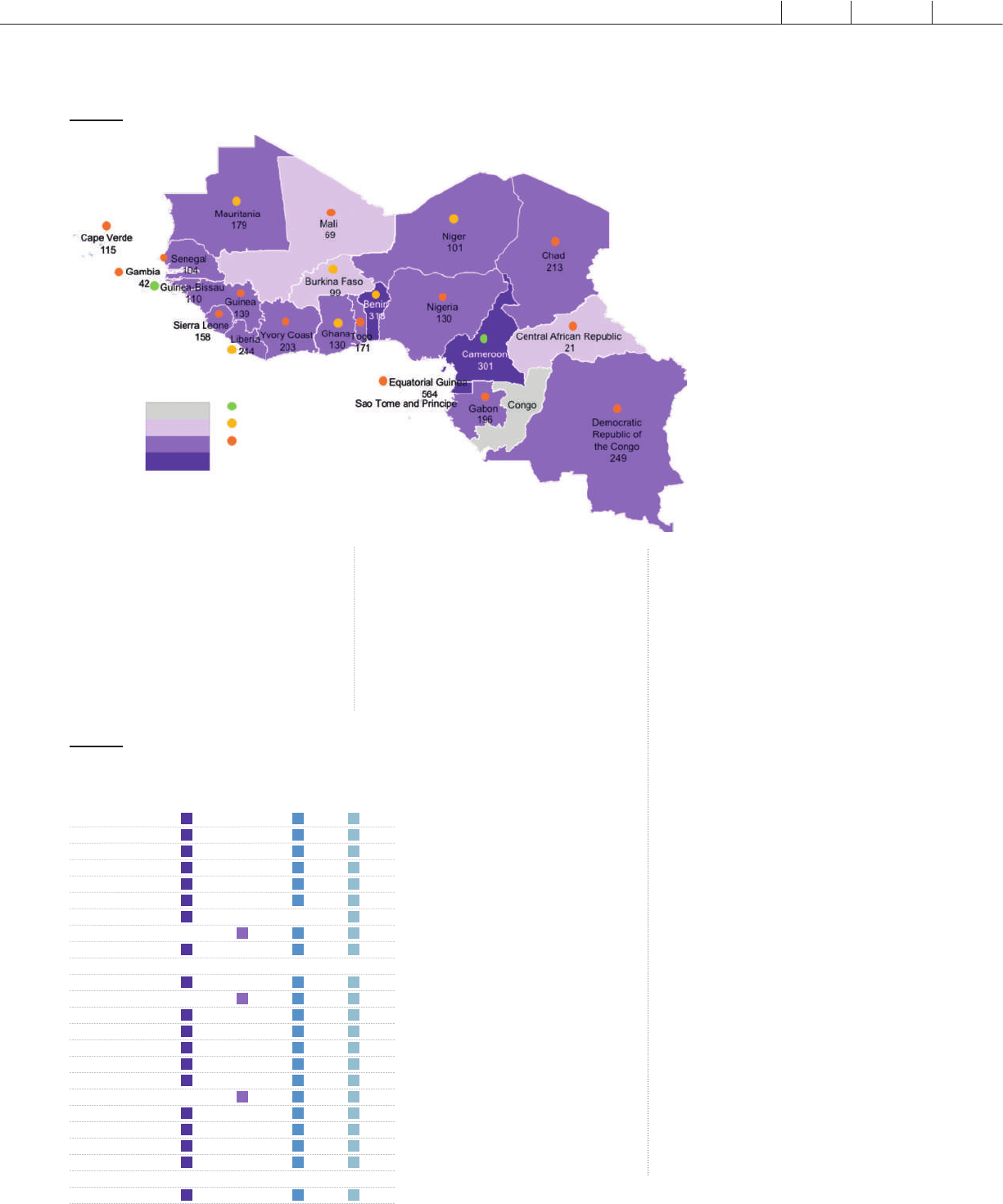
IDD NEWSLETTER MAY 2022 IDD IN WCA
3
children data, a cut-off school-age mUIC
≤ 175 μg/l correlated with an insufficient
iodine intake in pregnancy (mUIC ≤ 150
μg/l) (7). In the WCA region, eight coun-
tries had a school-age mUIC ≤ 175 μg/l,
which suggests that although school-age
children are iodine sufficient (8), pregnant
women are possibly iodine deficient. With
the increase in consumption of processed
foods it is significant to understand from
where the iodine is sourced, that is, from
iodized household salt or from processed
food made with iodized salt; this distinction
can be explored by stratifying mUIC by
household access to iodized salt. However,
in recent data only five national surveys
included this stratification.
There is a lack of updated
data in the region, and the
available data has insufficient
granularity for effective
monitoring and evaluation
of the USI program
In addition to the cost of large-scale
surveys, one of the main barriers to
assessing the population's iodine sta-
tus is the lack of laboratory capaci-
ty. There are only two countries in
Africa, namely, Tanzania and Ma-
dagascar, that are part of the CDC-
run Ensuring the Quality of Iodine
Procedures (EQUIP) program. This
is one of the largest standardisation
programs that addresses laboratory
quality-assurance issues related to
testing for iodine status. To increase
access to quality laboratories, there
is a need to increase the number of
laboratories as part of the EQUIP
program. These can act as reference
laboratories for the region.
Policy landscape for USI
and salt reduction
All but two countries (Sierra Le-
one and Equatorial Guinea) have
adopted mandatory salt iodization.
However, the legislation has not
been updated in most countries
since it was drafted and, therefore,
is not in line with the Economic
Community of West African States
(ECOWAS) standards that were
drafted in 2015 to facilitate trade
of iodized salt between countries.
With regard to the scope of the
legislation/standards, of the 22
countries where salt iodization is
mandatory, all specified that dome-
stically produced and imported salt
should be iodized, including salt for
processed food; twenty mentioned
iodized salt for animal feed
(Figure 3).
Enforcement of the legislation
remains weak in most WCA coun-
tries. In salt importing countries,
the customs officers deal with lengthy and
porous borders that facilitate the illegal im-
port of non-iodized salt. In salt producing
countries, the salt industry is fragmented,
with multiple small and artisanal producers
located in remote areas, making regular
enforcement difficult to conduct. Many
different agencies are involved in quality
control management, inspection, compli-
ance and control. However, roles and re-
sponsibilities among the numerous agencies
are not clear and/or aligned in all countries,
despite 15 countries having multi-sectoral
alliances that guide and legislate fortification
activities. Nevertheless, the recognition of
the need for salt iodization is well expressed
as part of the various country-level food
and nutrition security policies, plans and
programs, as well as in food fortification or
micronutrient strategies and guidelines in
the region. However, of the WCA regional
countries, only two countries have active
specific action plans/strategies/programs
focusing on salt iodization (Gabon and
Mauritania). The landscape exercise has
reinvigorated the USI program in some
countries as six new actions plans have been
drafted (Chad, Burkina Faso, Ghana, Mali,
Mauritania and Sao Tome et Principe).
After 30 years of programming, the interest
in USI has waned; Figure 3 shows a chro-
nogram of the last national activity/event
for USI in each country.
FIGURE 2
Median urinary iodine status of school-age children in West and Central Africa (6)
Median Urinary Iodine Concentration
Not available
<100 µg/L
100–300 µg/L
>300 µg/L
Date of the survey
<5 years
5–10 years
>10 years
FIGURE 3
Scope of salt iodization legislation
in West and Central Africa (9)
Benin
Burkina Faso
Cameroon
Cabo Verde
Central African Rep.
Chad
Republic of Congo
Côte d'Ivoire
Dem. Rep. of Congo
Equatorial Guinea
Gabon
Gambia
Ghana
Guinea
Guinea Bissau
Liberia
Mali
Mauritania
Niger
Nigeria
Sao Tome y Principe
Senegal
Sierra Leone
Togo
All types Excep- Domestical- Import
tions ly produced
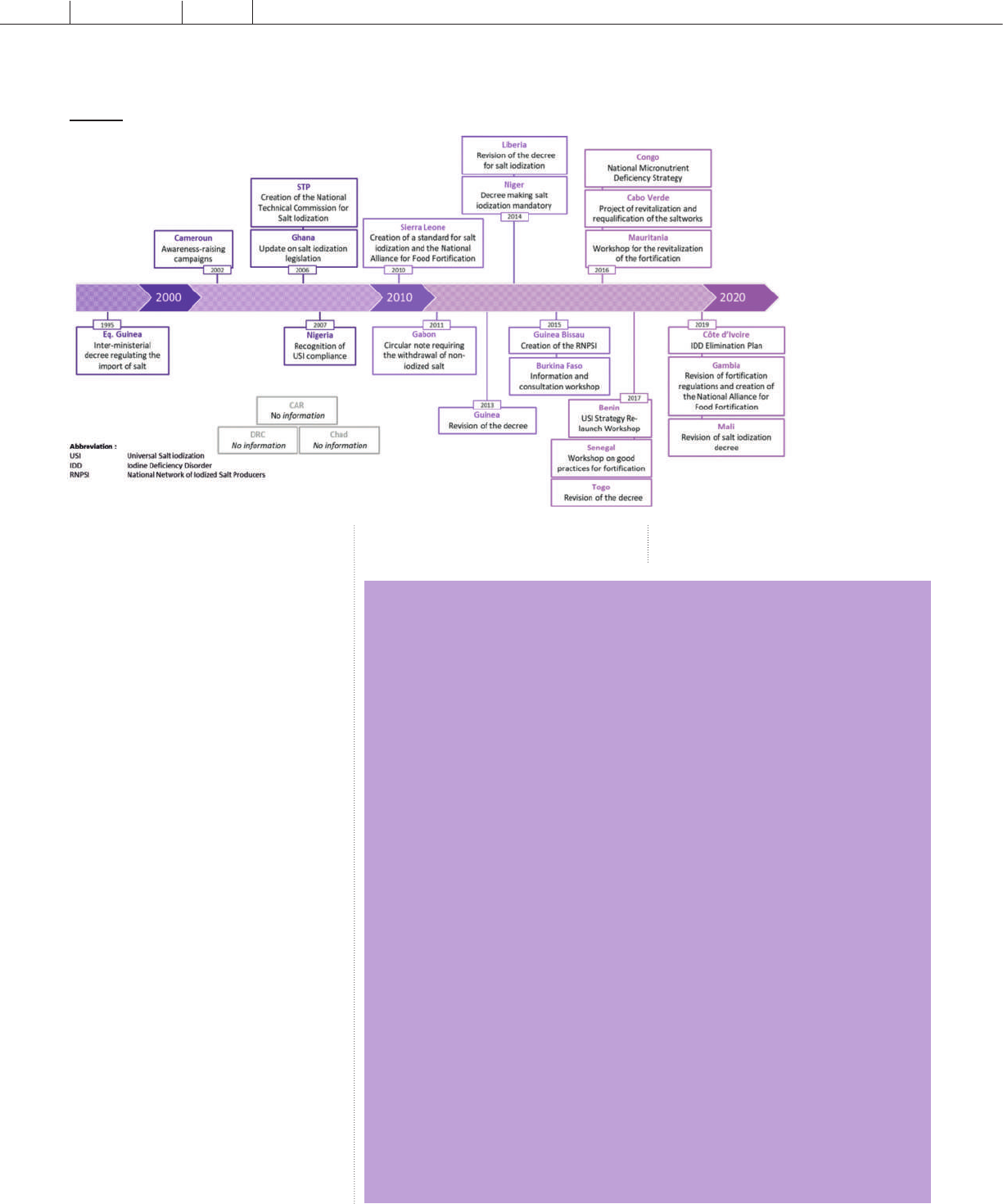
4
IDD NEWSLETTER MAY 2022 IDD IN WCA
For some countries, the last major national
activity/event dates to 2002; therefore,
there is an urgent need to reinvigorate the
regional interest in USI. Finally, countries
are developing salt reduction strategies
that should be implemented hand in hand
with salt iodization. To date, in the WCA
region, only four countries (Central African
Republic, Guinea Bissau, Nigeria and
Senegal) had salt reduction policies/strate-
gies or programs, and none were linked
to the USI program.
Salt production and trade
Only three countries have the natural
resources to produce salt in large enough
quantities to be exported. These are Ghana,
Senegal and Mauritania; however, Sene-
gal remains the largest exporter of salt in
the region. Other countries in the region,
namely Benin, Cape Verde, Chad, Gabon,
Gambia, Guinea, Guinea Bissau, Mali,
Niger, Nigeria and Sierra Leone, produce
smaller quantities of salt that is for locali-
sed use only; this salt is often not iodized.
Many producers in the region produce
poor quality and poorly iodized salt, if
iodized at all. This is mainly because the salt
industry is fragmented and characterised by
many small and artisanal producers that a)
are not committed to salt iodization, or b)
when they are, struggle to procure potassi-
um iodate and iodization equipment. Fre-
quently, they do not apply rigorous internal
quality control procedures due to a lack of
capacity and economic power to make the
necessary investments. Coupled with weak
enforcement, there is no repercussion for
their lack of iodising salt.
Details of the main salt producing countries
are described in the text box. (10)
FIGURE 4
Last USI event per country in West and Central Africa
Salt production in Senegal
With a coastline of more than 700 km and a series of flooding inlets, Senegal
has an enormous potential for salt production (10). Indeed, Senegal is one of
the biggest salt producers and exporters in the sub region, however, the salt sector
remains a very diversified and complex arena where a large single industrial
mechanised producer and one medium-scale industrial factory are responsible for
50–60% of the total salt produced per year; the rest (30%) is produced by over
15,000 artisanal producers that often operate informally at many traditional
collection sites. Iodization is carried out at the demand of the buyer purchase
of the salt.
Salt production in Ghana
Ghana is one of ten salt-producing countries in Africa and with its coastline of
573 km the country has the potential to produce approximately 3,000,000–
5,000,000 MT per annum; however, currently it is only producing 300,000–
350,000 MT of which 60–70% is exported, mainly to Burkina Faso, Niger, Togo,
Cote d’Ivoire and Benin. In 2013, 60 per cent of the salt output was processed
through modern methods, mainly by the medium-scale and some of the small-
scale producers who have the capacity to iodise, while the remaining 40 per cent
was processed through artisanal methods. Across the medium, small-scale and
artisanal categories of salt producers the preferred method for iodization is the
knapsack sprayer method which does not allow for homogenous iodization of the salt.
Salt production in Mauritania
The main type of salt produced in Mauritania is rock salt which is extracted from
three sites with an annual production of 31,000 tonnes per year. Wholesalers
in Nouakchott can iodise the salt at the request of the buyer. However, iodiza-
tion is rudimentary and is carried out using a plastic bottle with a hole in the top,
so that iodine distribution is not homogeneous. Salt from Mauritania is mainly
exported informally to Mali; however, there are talks to start exporting to other
countries in the region (11).
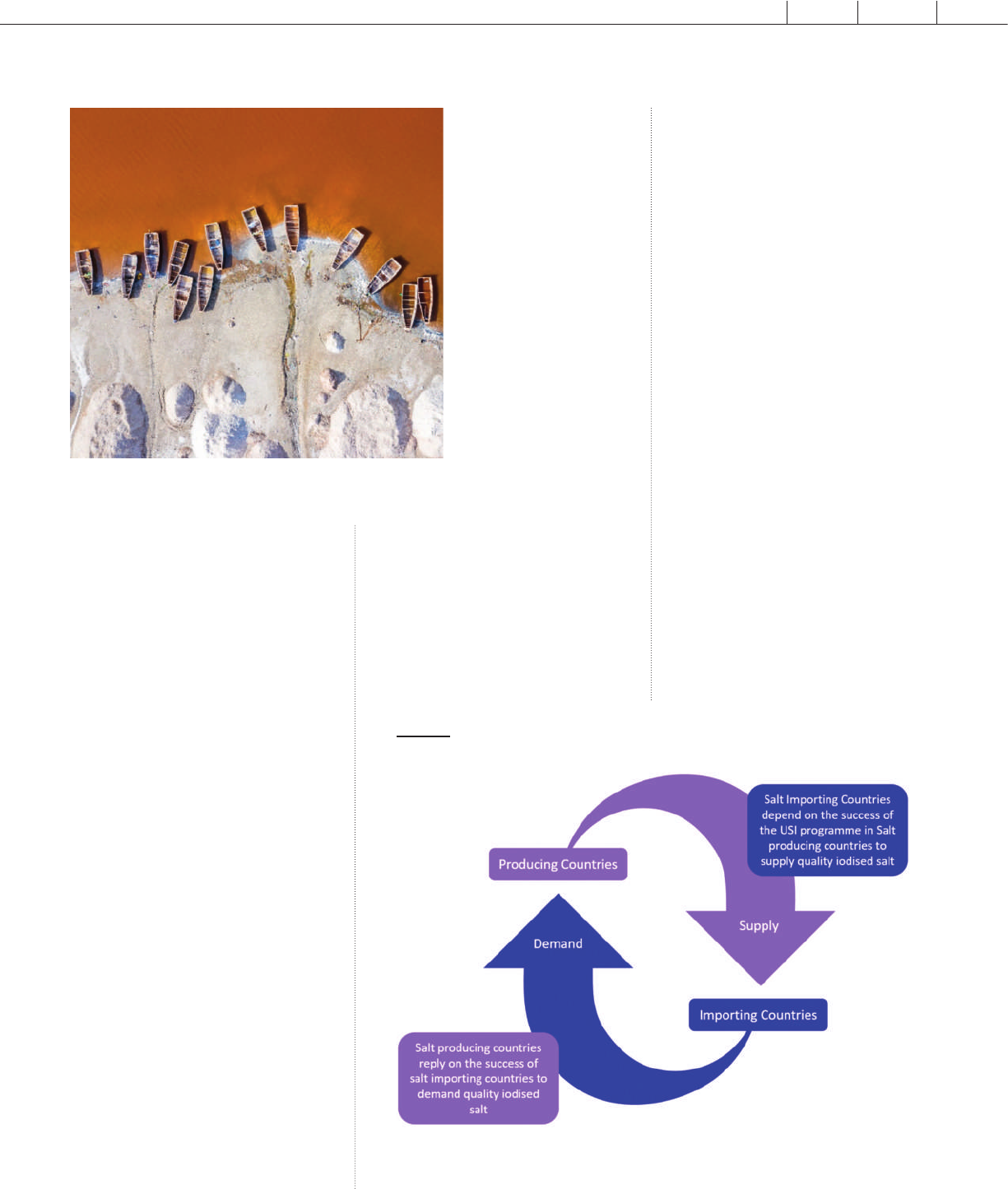
IDD NEWSLETTER MAY 2022 IDD IN WCA
5
In addition to these main salt producing
countries, Nigeria, Cameroon and Ga-
bon procure raw salt, refine and iodise it,
and then export the higher-grade salt to
neighbouring countries and beyond. A
more detailed description of the salt trade is
available in this issue of the IDD Newslet-
ter.(11)
Considering that most of the coun-
tries in WCA are salt importing, there is a
need to develop a symbiotic relationship
between salt importing and salt producing
countries. Salt importing countries de-
pend on the success of the salt iodization
programs of the salt producing countries
to supply quality iodized salt, and the salt
producing countries depend on the success
of the salt iodization programs in the im-
porting countries to demand quality iodized
salt (Figure 4).
Other sources of iodine in the diet
Global guidance around salt iodization has
mainly focused on adequate iodization of
household salt. However, with accelera-
ted urbanisation and rapid industrialisati-
on, there is an increased consumption of
industrially processed foods. This shift in
dietary patterns has resulted in processed
foods accounting for an increasing propor-
tion of total salt intake and subsequently
iodine intake if the salt is iodized. Even
though, ultra-processed and processed foods
should be minimised in household diets,
legislation should ensure that the iodization
standard should move from solely focusing
on table salt to ensure all
salt for human consump-
tion is iodized without
exceptions. The presence
and levels of iodine in salt
used in processed foods are
often unknown and should
be monitored to ensure
that salt consumption is
regulated and iodine status
remains within the optimal
range (12). The results of
a recent study (13), con-
ducted by IGN to assess the
consumption, production
and supply chain dynamics
of major sources of salt from
processed foods in West
Africa have significantly
shown that, processed food
made with iodized salt can
greatly contribute to the
iodine status of the popula-
tion. USI includes salt for animal feed; ho-
wever, there is little information on the use
of iodized salt for animal feed, which could
also become an important source of iodine
in the diet and improve the overall health
and productivity of the animals. Further
research is needed on the use of iodized salt
(or supplementation) in industrially produ-
ced animal feed in the WCA region.
Regional efforts toward strengthe-
ning and sustaining USI
To increase their collective influence,
countries within the WCA region have
combined into several regional economic
communities that could be leveraged to
support USI. In West Africa, as the official
health body of ECOWAS, the WAHO has
been key to advancing food fortification
since the USI resolution of 1994 (14). In
addition, the West African Economic and
Monetary Union (UEMOA), despite being
a monetary union, has also been highly
active in promoting food fortification,
including USI (14). Details of the main
regional activities are illustrated in Figure
5. Much of the regional work is limited to
countries in ECOWAS and, in some cases,
further limited to countries in UEMOA
only. Little, if any, regional work has invol-
ved the countries in Central Africa; more
engagement with the Economic Commu-
nity of Central African States (ECCAS) is
needed to ensure the supply of iodized salt
from West to Central Africa.
The political will and commitment of
regional health and economic bodies have
been critical to launching food fortification
across West Africa. Through the leadership
shown by these bodies, national govern-
ments abided by resolutions and recom-
mendations to initiate and mandate food
Aerial view of the pink Lake Retba or Lac Rose in Senegal.
Salt industry in West Africa.
©Photo by Curioso Photography on Unsplashed
FIGURE 5
Symbiotic relationship between salt importing and salt producing
countries in West and Central Africa
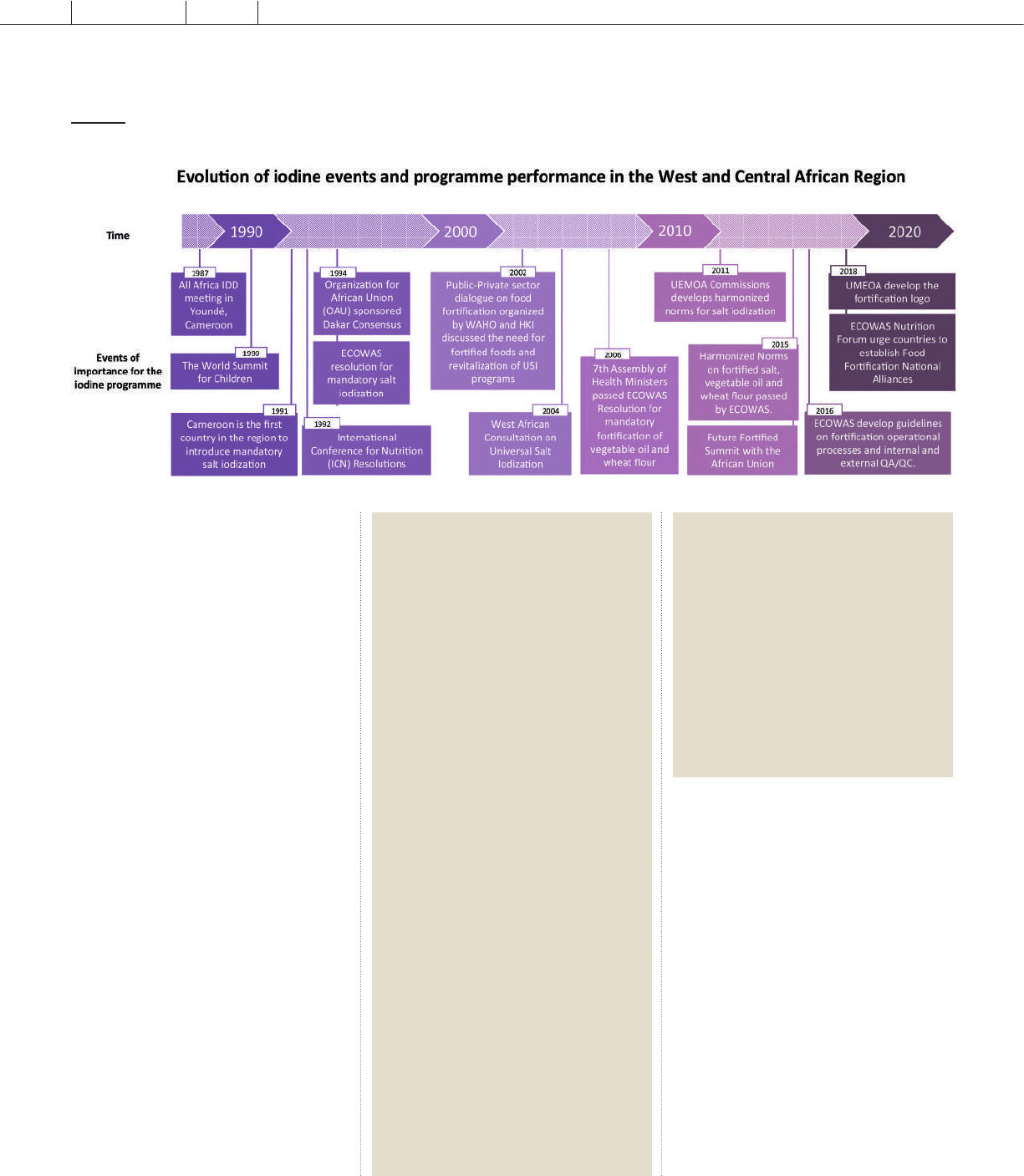
6
IDD NEWSLETTER MAY 2022 IDD IN WCA
fortification, including USI (14). However,
in the last 10 years, there has been limited
regional coordination and management by
these regional bodies in USI. Furthermore,
the issue of salt iodization in WCA is more
of a trade issue and, therefore, beyond the
scope of health alone.
In conclusion, the high coverage of
iodized salt and adequate iodine status has
culminated from a series of country-level
efforts spearheaded by regional support and
enhanced by national capacity to monitor
the USI program and enforce legislati-
on. However, in the last 20 years, there
has been little advancement in the USI
program performance in the WCA region
and little activity at the regional level in
the last 10 years. There is a risk that the
gains achieved to date may be reversed
if a conscious effort on USI is not made
considering the changes in the current
situation and lessons from past experiences.
There is a need to adopt an increased food
systems approach to USI programming; an
approach that considers all the elements
along the whole salt supply chain, including
their relationships and related causes and
effects. This will enable program mana-
gers to address today's gaps and adjust to
tomorrow's challenges through strengthe-
ning national positioning, improving
program management, including monito-
ring, assuring a stable supply and demand
for adequately iodized salt and focusing on
regional networks.
References
1. The World Bank. The World Bank in Western
and Central Africa [Internet]. 2020 [cited 2020
Jul 2]. Available from: https://www.worldbank.
org/en/region/afr/western-and-central-africa
2. UNICEF. The State of the World’s Children
2019. Children, Food and Nutrition: Growing
well in a changing world. 2019.
3. UNHCR. Update on UNHCR’s operations in
West and Central Africa - Feb 2022. 2022.
4. Gorstein JL, Bagriansky J, Pearce EN, Kupka
R, Zimmermann MB. Estimating the Health and
Economic Benefits of Universal Salt Iodization
Programs to Correct Iodine Deficiency Disorders.
Thyroid. 2020 Dec 1;30(12):1802–9.
5. UNICEF Global Databases on Iodized salt.
United Nations Children’s Fund, Division of Data
Analysis, Planning and Monitoring 2019. 2019.
6. Iodine Global Network (IGN). Global sco-
recard of iodine nutrition in 2020, in the general
population based on school-age children (SAC).
Ottawa, Canada; 2020 Jun.
7. Businge CB, Longo-Mbenza B, Kengne AP.
Iodine nutrition status in Africa: potentially high
prevalence of iodine deficiency in pregnancy
even in countries classified as iodine sufficient.
Public Health Nutr. 2021 Aug;24(12):3581–6.
8. IGN. Global scorecard of iodine nutrition
in 2020 - in the general population based on
school-age children (SAC) [Internet]. 2020
[cited 2022 May 14]. Available from: https://
www.ign.org/cm_data/Global-Scorecard-2020-
3-June-2020.pdf
9. Global Fortification Data Exchange. Forti-
fication Legislation Scope in Countries with
Mandatory Fortification [Internet]. [cited 2021
Jun 28]. Available from: https://fortificationdata.
org/plot-fortification-legislation-scope-in-coun-
tries-with-mandatory-fortification/
10. Dr Gayane FAYE. Cartographie des Sites
de Production Artisanale de Sel et Etude de la
Filiére Sel au Sénégal. 2018.
11. Maurel M. Etude transversale de la dispo-
nibilité des produits alimentaires de grande
consommation enrichis en micronutriment en
Mauritanie : état des lieux et analyse des goulots
d’ét ranglement à des fins de plaidoyers. 2019
Aug.
12. IGN. Program Guidance on the Use of
Iodized Salt in Industrially Processed Foods
[Internet]. 2021. Available from: https://www.
ign.org/program-guidance-on-the-use-of-iodi-
zed-salt-in-industrially-processed-foods.htm
13. IGN. Assessment of the potential contributi-
on of iodine from salt in processed foods in West
Africa [Unpublished manuscript]. 2021.
14. Grant F, Tsang BL, Garrett GS. Food Fortifi-
cation in West Africa. SAL 2018. 2018.
FIGURE 6
Chronology of key events that have helped to shape the Iodine agenda
in the West and Central African region
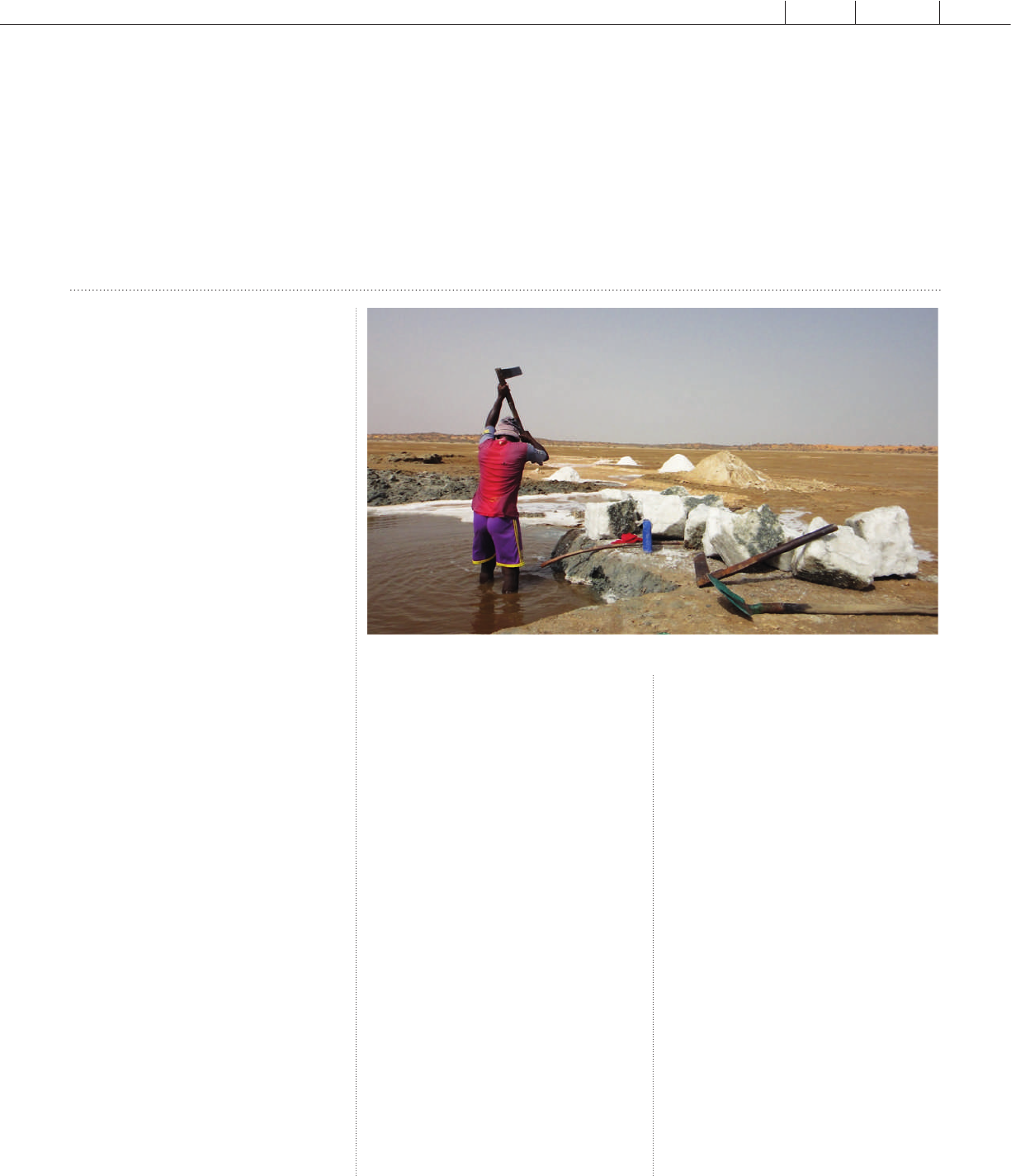
IDD NEWSLETTER MAY 2022 MAURITANIA
7
Potential for salt production
in Mauritania
Introduction
To contribute to the sustainable elimi-
nation of iodine deficiency disorders in
West and Central Africa, the United
Nations Children's Fund (UNICEF) and
IGN established a partnership to sup-
port national and regional efforts to scale
up and sustain universal salt iodization.
One of the initiatives was to conduct
a landscape analysis to develop a com-
mon understanding of the situation and
bottlenecks at national and regional levels.
Mauritania was selected for an in-depth
analysis because of its significant local rock
salt production and because it is one of
the countries where a joint IGN/UNI-
CEF rapid assessment is planned with the
Ministry of Health. This analysis described
the historical context of the salt iodization
program, its evolution, and its status, as
well as the main favorable and unfavorable
factors for salt iodization in Mauritania.
Specifically, the evaluation focused on the
following elements of the program: nati-
onal policies and strategies, legislation and
regulations, management of the program,
communication, use of iodized salt in
processed foods, and monitoring. A mixed
methodology was used to collect data
and information on the status of “iodized
nutrition” and on universal salt iodiza-
tion policies and programs. This involved
a literature review and interviews with
resource persons. Relevant documents
were collected through web searches,
and from national and regional develop-
ment partners. For the key informant
interviews, we identified and interviewed
national stakeholders from government,
the private sector, academia, civil society,
and development partners who have a
direct role in the implementation of the
iodine program. UNICEF country offices
and other development partners assisted in
identifying these stakeholders. (1).
Background
Mauritania's commitment
For more than two decades, Mauritania
has been committed to the fight against
iodine deficiency, which was first identi-
fied in 1995. The official adoption of the
IUS strategy by Mauritania was marked
by the signing of Decree No. 2004-034
in April 2004, making iodization of all salt
intended for human and animal consump-
tion mandatory (2). This decree covers
the entire supply chain and clearly defines
the components used for fortification,
packaging standards, impurity levels and
penalties for infractions. The iodide or
iodate iodization levels of salt are defined
as follows for the different supply steps:
• Import and export: 80-100 ppm
• Production: 50-80 ppm
• Retail: 40 ppm for 25kg bags and
25 ppm for small quantities of salt.
The Mauritanian government has also
signaled its commitment to addressing
iodine deficiency by including it in natio-
nal nutrition policies, plans and strategies.
However, there is no longer an updated
roadmap on how salt iodization should be
achieved. Only the National Strategy for
Accelerated Growth and Shared Prosperi-
ty SCAPP (2016-2030) and Multisectoral
Strategic Plan for Nutrition 2016-2025
are still active. On the other hand, there
is no national strategy to reduce salt con-
sumption.
At the same time, many actions have
been taken to support universal salt iodi-
zation: different actors have been trained,
materials have been provided to produ-
cers and to the services in charge of the
control of iodization, an association of salt
producers in Mauritania has been formed,
and the Alliance for Food Fortification in
Mauritania (AFAM) has been created but
has not yet been formalized (1).
Population status
To ensure surveillance at the household
level, qualitative analysis of household salt
using rapid test kits have been included in
the national SMART surveys. However,
national laboratories are not able to per-
form urinary iodine analysis to determine
the iodine status of the population.
Mathilde Maurel, Nutrition Consultant, Iodine Global Network, Mohamed Baro, Nutrition Specialist, UNICEF, Isselmou Ould Mohamed, Independent Consultant
Mauritanian salt producer on the production site of N'Teret (July 2019)
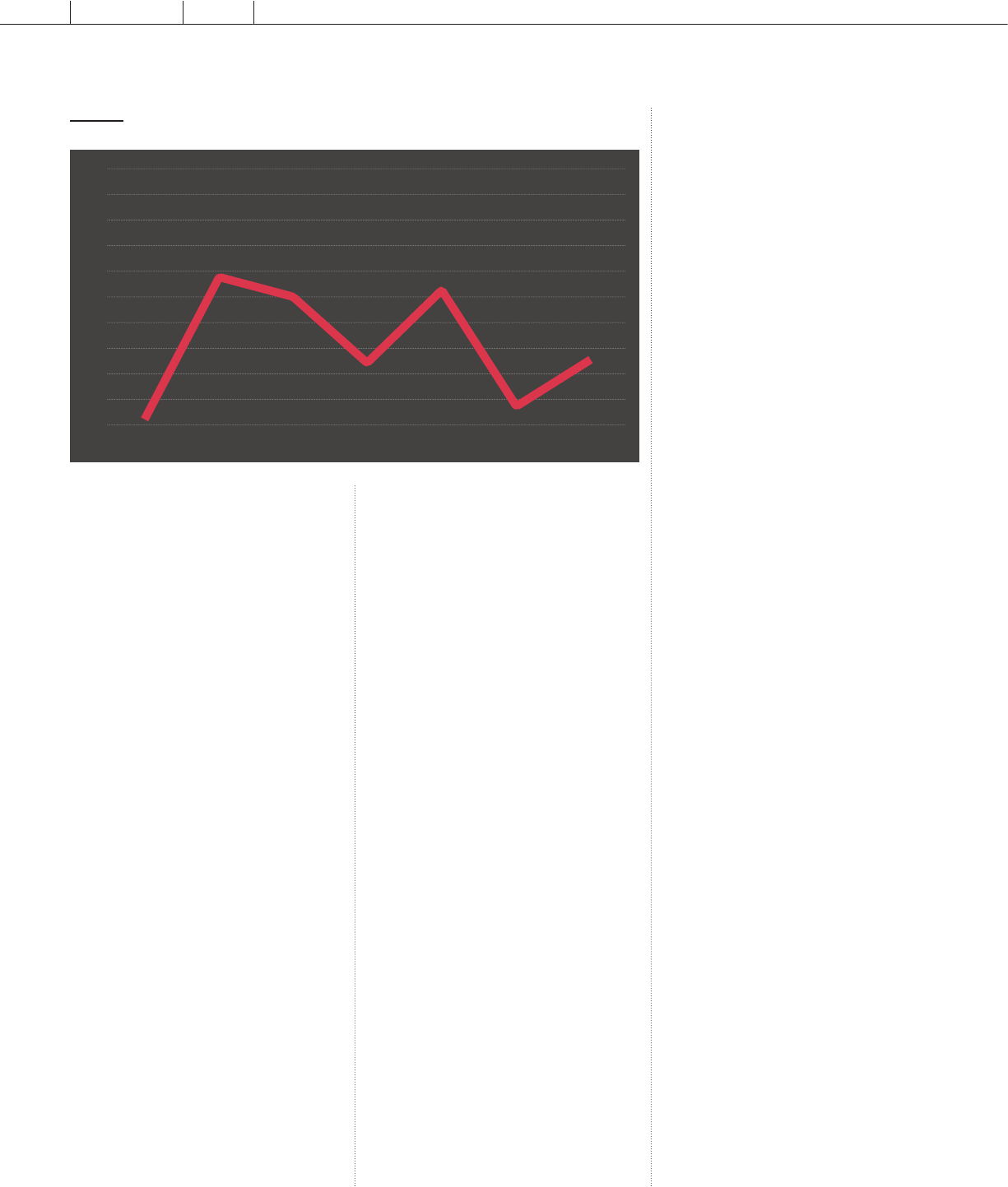
According to the latest Iodine Deficiency
Disorders Survey in 2012, the median
urinary iodine level of school-aged
children was 179μg/L suggesting iodine
adequacy at a national level. Regarding
household iodized salt coverage, Maurita-
nia has experienced many fluctuations as
illustrated in Figure 1. The latest available
data indicate that 25 % of households
are covered with iodized salt (> 0 ppm).
The same survey showed considerable
variation in the proportions of households
with iodized salt by place of residence
or wealth quintile. Households residing
in urban areas were more likely to have
iodized salt, and by wealth quintile, the
wealthiest households were three times
more likely to use iodized salt (1).
Opportunities
Salt resources
Mauritania has a large salt resource with
an annual production that covers more
than its salt needs. The country is able to
produce two types of edible salt on its ter-
ritory, namely rock salt, which constitutes
80% of the total production, and sea salt
through its 600 km of coastline.
Sea salt production is mainly located
around Nouadhibou and annual produc-
tion amounts to 5,000 MT. Rock salt
extraction is carried out on 3 main pro-
duction sites whose access is often difficult
and infrastructure limited. The annual
production of rock salt amounts to 31,000
MT, which is more than double the
country's salt needs (3). The Association
of Salt Producers of Mauritania (APSM)
was created in 2005, and then the perso-
nnel of the 3 main salt production sites
were trained in salt iodization. Today, the
APSM is still functioning and continues
to be committed to salt iodization but
believes that the lack of government con-
trol and the importation of non-iodized
salt from neighboring countries creates
unequal conditions and discourages its
members from iodizing their salt.
However, given that the number
of rock salt producers is limited and that
most salt is centralized in the capital, this
represents a real opportunity for salt con-
solidation and iodization.
Demand from neighboring countries
Due to salt production exceeding the
country's needs, Mauritania can export
part of its production. The main impor-
ters of Mauritanian salt are Côte d'Ivoire
and Mali, and negotiations are underway
to expand exports to the Democratic
Republic of Congo.
Mauritania, which was a founding
member of the Economic Community of
West African States (ECOWAS) in 1975,
withdrew in December 2000 but recently
signed a new partnership in August 2017.
This new agreement offers an interesting
opportunity to strengthen Mauritania's
trade agreements with neighboring coun-
tries and to benefit from harmonized stan-
dards on iodized salt in the region. This
could allow Mauritania to develop exports
of its salt stocks to neighboring countries
(1).
Implementation of an action plan
Following the landscape analysis carried
out in the context of the partnership
between ING and UNICEF, a work-
shop was held in Nouakchott, bringing
together the main actors in salt iodization.
After the presentation of the situation and
discussions between the different decision
makers, an Action Plan for a sustainable
revitalization of the salt iodization and
iodine nutrition program in Mauritania
was developed (4). The main key messa-
ges of this action plan have been detailed
in the box below. This action plan is an
opportunity to revitalize salt iodization
activities and renews the government's
commitment to include salt iodization as a
priority objective.
Obstacles and possible
improvements
Quality of salt
Although salt resources are important,
the quality of salt is not sufficient. The
precarious conditions of the production
sites do not allow for proper iodization of
the salt. Once the salt blocks are extracted
manually from the deposits, they are
transported to Nouakchott to be crushed
and stored in 25 kg bags. Nouakchott
wholesalers can iodize salt on demand
from customers, but iodization is not
systematic. In addition, the iodization
units provided by UNICEF are obsolete
and works in fits and starts, so wholesalers
perform rudimentary iodization using
a pierced bottle that does not allow for
homogeneous iodization of the salt (3).
Considering the centralization of salt
in Nouakchott and transportation along
three main routes that intersect before
Nouakchott, the government is studying
the possibility of setting up a centralized
iodization facility to consolidate, process
and iodize salt from the main producers.
On the other hand, there is unfair com-
petition as producers sell non-iodized sea
salt and rock salt at low prices but of poor
quality. Producers do not see the point or
the constraint of iodizing their salt if they
can sell it non-iodized (1).
FIGURE 1
Trends of household iodized salt (>0ppm) coverage between 2000
and 2018
100
90
80
70
60
50
40
30
20
10
0
DHS-2000 SMART.2008 SMART-2010 MICS-2011 TDCI-2012 MICS-2015 SMART-2018
58
50
24
53
8
25
2
8
IDD NEWSLETTER MAY 2022 MAURITANIA
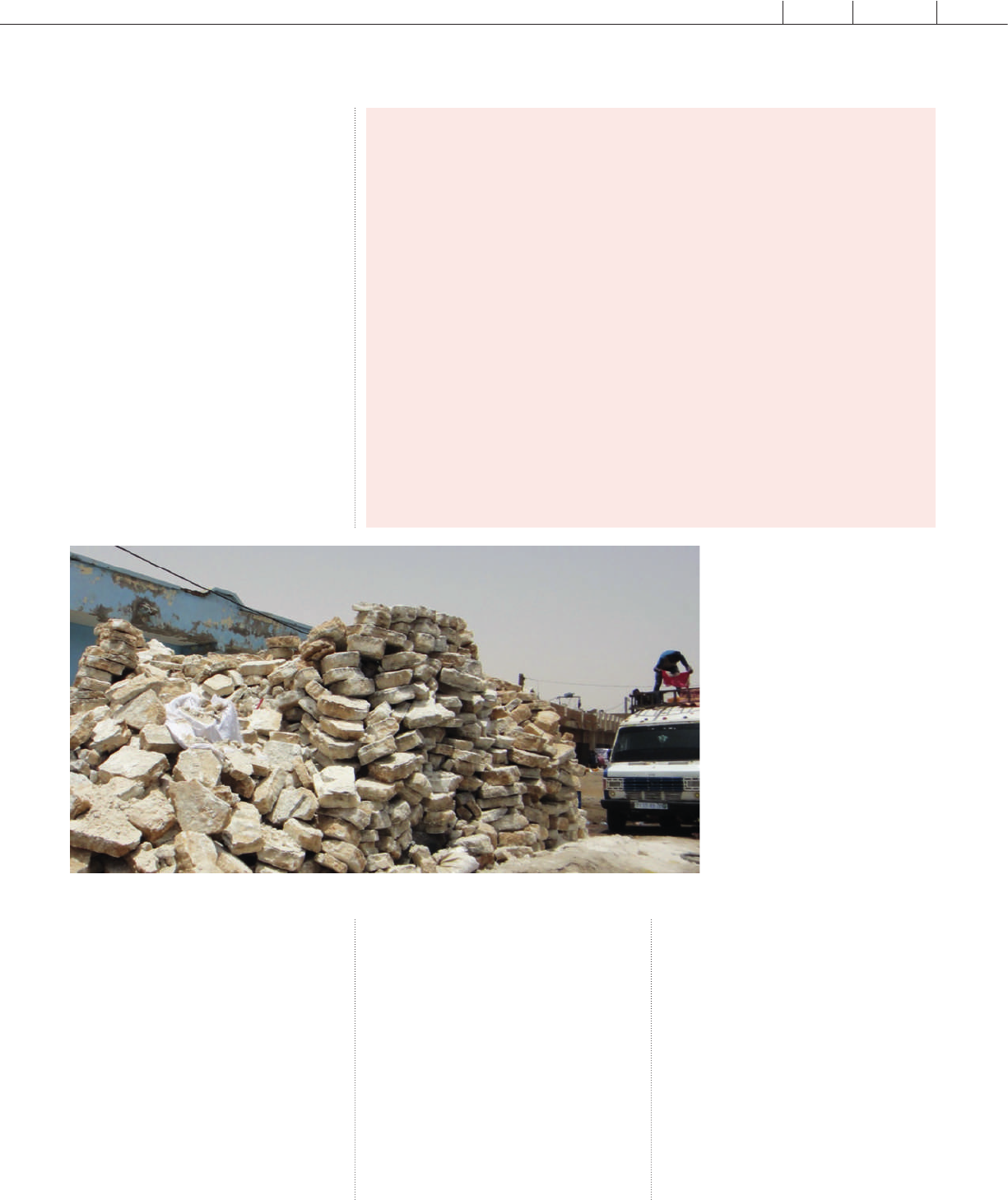
Sustainable financing
The Accelerated Growth Plan requires
individual ministries to establish their
own budget line for food fortification,
including salt iodization. However, fun-
ding for the salt iodization program relies
on donors such as UNICEF and in the
past by the World Bank and the United
Nations Industrial Development Organi-
zation (UNIDO). In 2020, the Ministry
of Commerce, Industry and Tourism tried
to allocate funds to USI for an awareness
campaign, but COVID did not allow this
project to proceed (1). It is important to
encourage other relevant ministries to
include a budget line in the USI program.
Rock salt purchase and use habits
The consumption habits of Mauritani-
an households constitute a challenge in
opposition to the opportunity. Maurita-
nian diets do not include powdered salt;
women cook directly with rock salt.
In a focus group conducted in 2019,
women stated that they do not know how
to cook with powdered salt and find that
iodized salt has a bitter taste (3). These
statements indicate a need to raise aware-
ness among the population about the use
of iodized salt to increase the demand for
local iodized salt among retailers.
Legislation
There are weaknesses in the current
legislation, a revision of this decree would
be necessary to include: the use of iodized
salt in processed foods, the use of only
one type of iodine compound for for-
tification, the protocol of the method
of quantitative evaluation of iodine, the
quality certification and for the removal of
all exceptions for the use of non-iodized
salt (1).
References
(1). Amal Tucker Brown, Dedenyo Adossi, Mathilde
Maurel et Arnold Timmer, Analyse situationnelle du
programme d'iodation universelle du sel en Maurita-
nie, Septembre 2021 IGN et UNICEF
(2). Ministre de la santé et des affaires sociales,
2004. Décret mau 86862 n°034 - 2004 Portant
obligation d’ioder le sel destiné à l’alimentation
humaine et animale.
(3). Maurel, M., 2019. Étude transversale de la
disponibilité des produits alimentaires de grande
consommation enrichis en micronutriment en
Mauritanie : état des lieux et analyse des goulots
d’étranglement à des fins de plaidoyers.
(4). Isselmou Ould Mohamed. Plan d’action Pour
Une Redynamisation Pérenne Du Programme
d’iodation Du Sel et de Nutrition En Iode En Mau-
ritanie, 2021 République Islamique de Mauritanie,
UNICEF, IGN.
Key Message of the Action Plan
Policy, strategy and coordination
• Advocacy for the inclusion of salt iodization in national sectoral programs.
• Organization of a data collection system (HHIS and mUIC).
• Update legislation.
• Define roles, responsibilities, and budgetary needs.
Salt production and iodization process
• Promote the creation of three economic interest groups in the production areas.
• Promote the establishment of a centralized industrial iodization facility.
Monitoring and control
• Clarify the roles and responsibilities of the institutions involved in monitoring.
• Inform customs officers about the legislation
• Require certification from exporting countries to allow salt entry.
• Involve national laboratories in the control and monitoring system.
Awareness and Advocacy
• Formalize the Food Fortification Alliance and include the Salt Iodization
Committee.
• Communicate the importance of salt iodization and legislation to retailers,
wholesalers and importers.
Rock salt extraction basin in N'teret (2019)
IDD NEWSLETTER MAY 2022 MAURITANIA
9
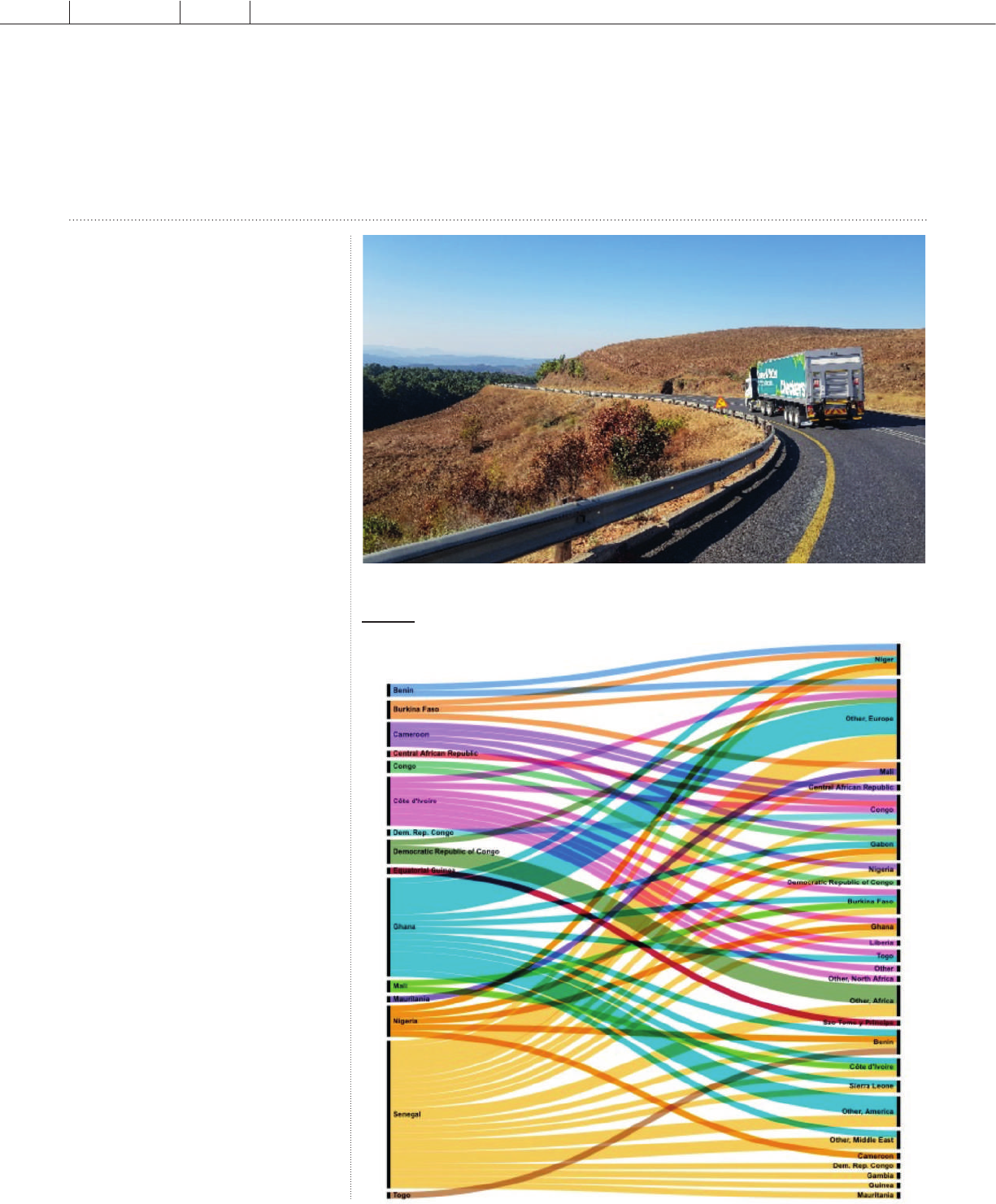
Salt trade in West and Central Africa
Trade is crucial for economic growth
and food security. West and Central
Africa (WCA) have huge potential for
trade in global and intra-regional terms.
This is particularly true for salt because
of its natural resource endowment and
intra-regional complementarities (salt-
producing and salt-importing countries).
In the WCA region, only three countries
have the natural resources to produce salt
in large enough quantities to be exported.
These are Ghana, Senegal, and Maurita-
nia. However, Senegal remains the largest
exporter of salt in the region.
In addition to above mentioned main
producing countries, Nigeria, Cameroon,
and Gabon procure raw salt, refine and
iodise it to export the higher quality salt
to neighbouring countries and beyond.
Lastly, many countries are involved in
're-exportation', which involves exporting
goods they imported without altering
them. This is particularly true of salt
transported from coastal to landlocked
countries in the region, which are subject
to multiple border checks. The trade of
salt from countries in WCA and their
destination is illustrated in Figure 1.
A study on the potential of food trade
in the Economic Community of West Af-
rican States (ECOWAS) region found that
food export by all the member countries
represented only 5% of the ECOWAS
intraregional trade. Moreover, the study
concluded that all countries of the region
are yet to fully exploit their potential in
the trade of food commodities within
the region (1). In the case of salt, despite
having sufficient natural resources within
the region to supply salt, many countries
import from outside the region. Of the
1.2 million tons of salt formally declared
and traded in the WCA region in 2020,
just under half was from a WCA country,
the remaining from outside the region
(table 1). Nigeria, the biggest importer of
salt, imported USD$77 million worth of
salt in 2020 (2). It prefers to import its salt
from outside the region, most likely due
to the ability of the region to produce en-
ough high-quality salt and, in some cases,
due to existing trade dynamics.
Amal Tucker-Brown, IGN WCA regional coordinator and Mathilde Maurel, IGN consultant
Salt truck in South Africa (Photo by Nelson Gono on Unsplash)
Adapted from UN COMTRADE
FIGURE 1
Trade of Salt from Countries in West and Central Africa
Export country
Import country
10
IDD NEWSLETTER MAY 2022 SALT TRADE
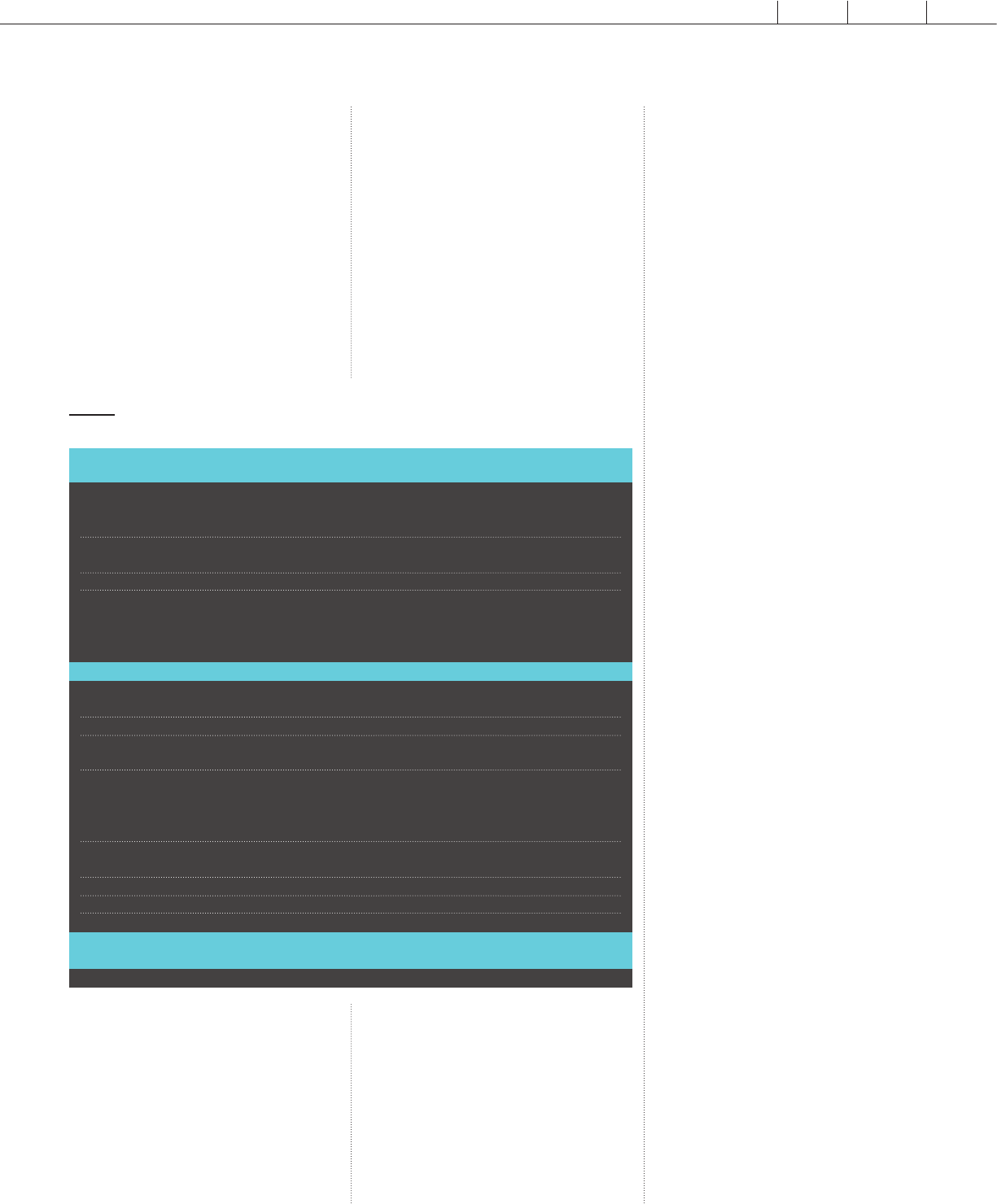
Nigeria imports the majority of its salt
from Brazil (3).
However, it is important to note that
75% of intra-regional trade is informal (4).
Informality occurs due to efforts to avoid
regulatory and transaction costs and the
deep fragmentation of supply chains, as
is the case in the salt-producing indus-
try in Senegal and Ghana. This informal
trade faces high uncertainty and costs and
therefore is not economical, preventing
investment and economies of scale. Fur-
thermore, informal intra-regional trade is
not subjected to quality controls to ensure
that the salt is adequately iodised (4).
Enhancing intra-regional trade along
with value chain development (through
increased production of quality salt and
value addition through iodisation) will not
only improve the availability of quality io-
dised salt, but it is also believed to contri-
bute to economic growth and sustainable
development, as indicated in key regional
and pan African policy frameworks (4).
This stems from the fact that it creates
opportunities for economies of scale and
allows for the flow of salt from salt-pro-
ducing countries/areas to salt-importing
countries/areas. Finally, improving intra-
regional trade has also been shown to
increase foreign direct investment (5,6),
which for the salt industry would increase
the supply of quality iodised salt circula-
ting in the region for both the household
level and the food industry.
Regional trade facilitation
and barriers
African countries and the WCA countries
have long been collaborating on regional
trade agreements as part of a broader
strategy for strengthening trade ties. The
removal of formal tariff barriers should,
in theory, lead to a significant increase in
trade flows. However, much of the focus
has been put on tariff barriers to trade,
leaving out non-tariff barriers that could,
in some cases, be associated with more
constraints to trade than the formal tariffs.
A non-tariff barrier is any measure other
than a customs tariff that acts as a barrier
to international trade(7). This is likely the
case for salt, where differences in norms
and standards (in iodine levels and quality
of salt) and lengthy and costly laboratory
testing of salt at the borders can act as
important non-tariff barriers (7).
The intra-regional trade of salt has
not been examined in depth. However, in
2016, the European Centre for Develop-
ment Policy Management reviewed the
agricultural and food trade in ECOWAS.
The review found that part of intra-regio-
nal trade flows through main regional cor-
ridors. This main West African transport
network (i.e., the West-East Trans-
Sahelian Highway between Dakar and
Ndjamena, the Trans-Coastal highway
between Dakar and Lagos and the inter-
connecting North-South corridors) serves
extra-regional, intra-regional and national
trade. Therefore, the smooth functioning
of these corridors is of great importance
for trade in the region. Additionally, they
also found considerable intra-regional
trade flow outside these main regional
corridors. This applies to trade that occurs
around border areas and where produc-
tion basins are not in the direct vicinity of
a corridor, as is often the case for salt.
Finally, the time it takes to get goods
from a producer to a buyer is an impor-
tant determinant of trade costs (8). Accor-
ding to the World Bank's annual Doing
Business report, trading in several African
countries requires three times as many
days, nearly twice as many documents and
six times as many procedures compared to
high-income economies (9). Every extra
day it takes in Africa to get a consign-
ment to its destination is equivalent to a
1.5% additional tax (9). This increase in
cost will increase the cost of iodised salt
that is formally imported and increase the
informal trade of salt that is more likely to
be inadequately iodised.
Therefore, to increase the availabi-
lity of quality iodised salt in the region,
a more in-depth analysis of the trade
barriers and facilitators is needed to design
and implement policies to promote intra-
regional trade, identify trade facilitation
initiatives and support value chain deve-
lopment of iodised salt (9).
Harmonisation of salt standards
As mentioned above, standards and norms
can act as an important non-tariff barrier
to trade. Therefore, to facilitate the regi-
onal trade and distribution of iodised salt,
a workshop was organised in late 2013 to
reach a consensus on and plan the process
From Quantity To
(Region) (MT) (Countries)
Senegal 402,419 Burkina Faso, The Congo, Côte d'Ivoire, Democratic
Republic of Congo, Gabon, Gambia, Ghana, Guinea,
Mali, Mauritania, Niger, Nigeria, Sierra Leone
Ghana 130,550 Benin, Burkina Faso, Côte d'Ivoire, Gabon, Niger,
Sierra Leone, Togo
Mauritania 1,285 Mali
Other WCA country 4,628 Benin, Burkina Faso, Cameroon, Central African
Republic, Congo, Côte d'Ivoire, Democratic Republic
of Congo, Gabon, Ghana, Liberia, Mali, Niger,
Nigeria, Sao Tome and Principe
Sub-Total WCA region 538,882
Africa (not WCA region) 118,495 Angola, Ethiopia, Kenya, Mauritius, Namibia,
Rwanda, South Africa, Uganda, Zambia
The Americas 376,438 Antigua and Barbuda, Brazil, Canada, Chile, USA
Asia 35,367 Bangladesh, China, India, Japan, Korea, Malaysia,
Pakistan, Singapore, Sri Lanka, Thailand, Turkey
Europe 14,723 Austria, Belgium, Czech Republic, Denmark, France,
Germany, Greece, Iceland, Italy, Lithuania, Luxem-
bourg, Netherlands, Norway, Poland, Portugal, Spain,
Switzerland, United Kingdom
Middle East 35,097 Bahrain, Israel, Lebanon, Oman, Saudi Arabia,
United Arab Emirates
North Africa 26,446 Algeria, Egypt, Libya, Morocco, Tunisia,
Oceania 25,039 Australia
Others 0.28 Others
Sub-Total 631,605
Non-WCA region
Total 1,170,487
TABLE 1
Import of salt into West and Central African countries from within
and outside the region in 2019 (2)
IDD NEWSLETTER MAY 2022 SALT TRADE
11
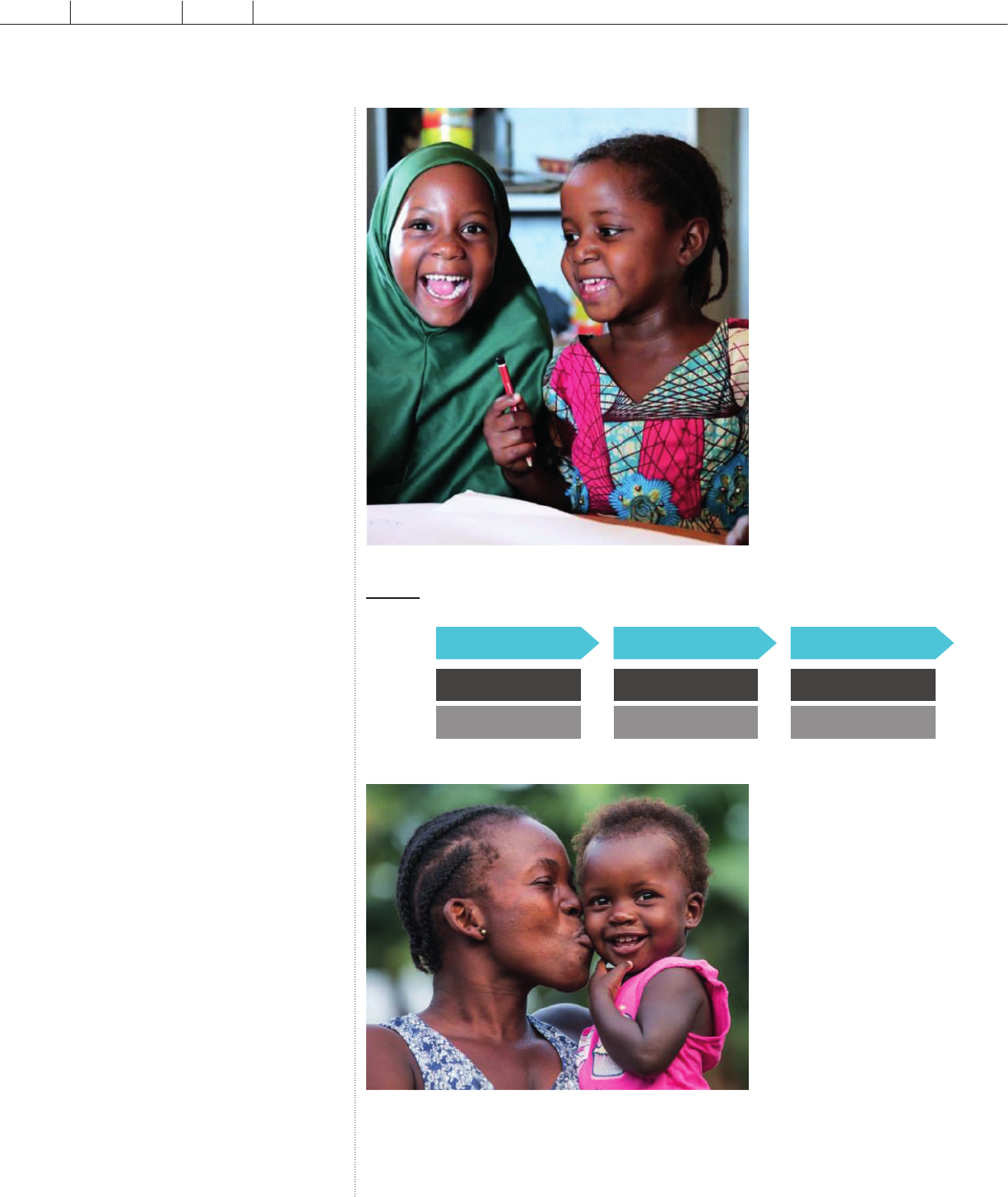
for harmonising standards for fortified
wheat flour, vegetable oil and iodised salt
across the entire 15-member ECOWAS
community through the ECOWAS Har-
monization Model (ECOSHAM), the fra-
mework for aligning commodity standards
in the region (10). Furthermore, in 2015,
ECOWAS published its salt iodisation
norms (ECOSTAND 48:2015), stating
that adopting a harmonised regional stan-
dard for food-grade salt would facilitate
trade globally and within ECOWAS.
The ECOWAS norm states the ma-
ximum and minimum levels for the iodi-
sation of food-grade salt along the supply
chain. Iodine in salt must not be less than
50 mg/kg at the point of production, 30
to 60 mg/kg at importation/exportation
and 20 to 60 mg/kg at wholesale and
retail levels.
The ECOWAS norm also provides
compositional and quality specifications
for fortified food grade salt. These include
the moisture level, sodium chloride level
(to define purity) and limits of impurities.
Hygienic conditions under which salt
should be produced and handled throug-
hout its distribution, packaging materials,
labelling and methods for testing compli-
ance are also provided. The ECOWAS
norm recommends that food-grade iodi-
sed salt be produced only by producers
with the requisite knowledge and neces-
sary equipment for processing quality salt,
dosing with iodine and ensuring thorough
mixing to obtain a homogeneous mixture.
The ECOWAS member states were
encouraged to adopt the regional ECO-
WAS norm on fortified food grade salt,
replacing their existing legislation/stan-
dard/norms. However, only Senegal has
adopted the ECOWAS norm. There is no
clarity why the other countries have not
adopted the ECOWAS norms, and many
have remained faithful to the WAEMU
norm, which has slightly different iodine
levels along the supply chain (Figure 2).
The import level of iodine (along
with the quality parameters) is signifi-
cant in the trade of iodised salt. Figure 3
shows the difference in the import level
of iodine. For most countries, there is an
overlap in the iodine level; therefore, har-
monising the standards regarding iodine
level and quality of salt would not signi-
ficantly change the amount of iodine in
the salt in each country and could remove
a potentially difficult non-tariff barrier to
trade.
Production Importation Wholehouse/ Retail
> 50 ppm 30–60 ppm 20–60 ppm
30–60 ppm 30–60 ppm 20–60 ppm
ECOWAS
WAEMU
FIGURE 2
ECOWAS and UEMOA norms at the production, import and retail levels
12
IDD NEWSLETTER MAY 2022 SALT TRADE
© UNICEF/UN0443455/Dejongh
© UNICEF/UN0418066/ Vincent Tremeau
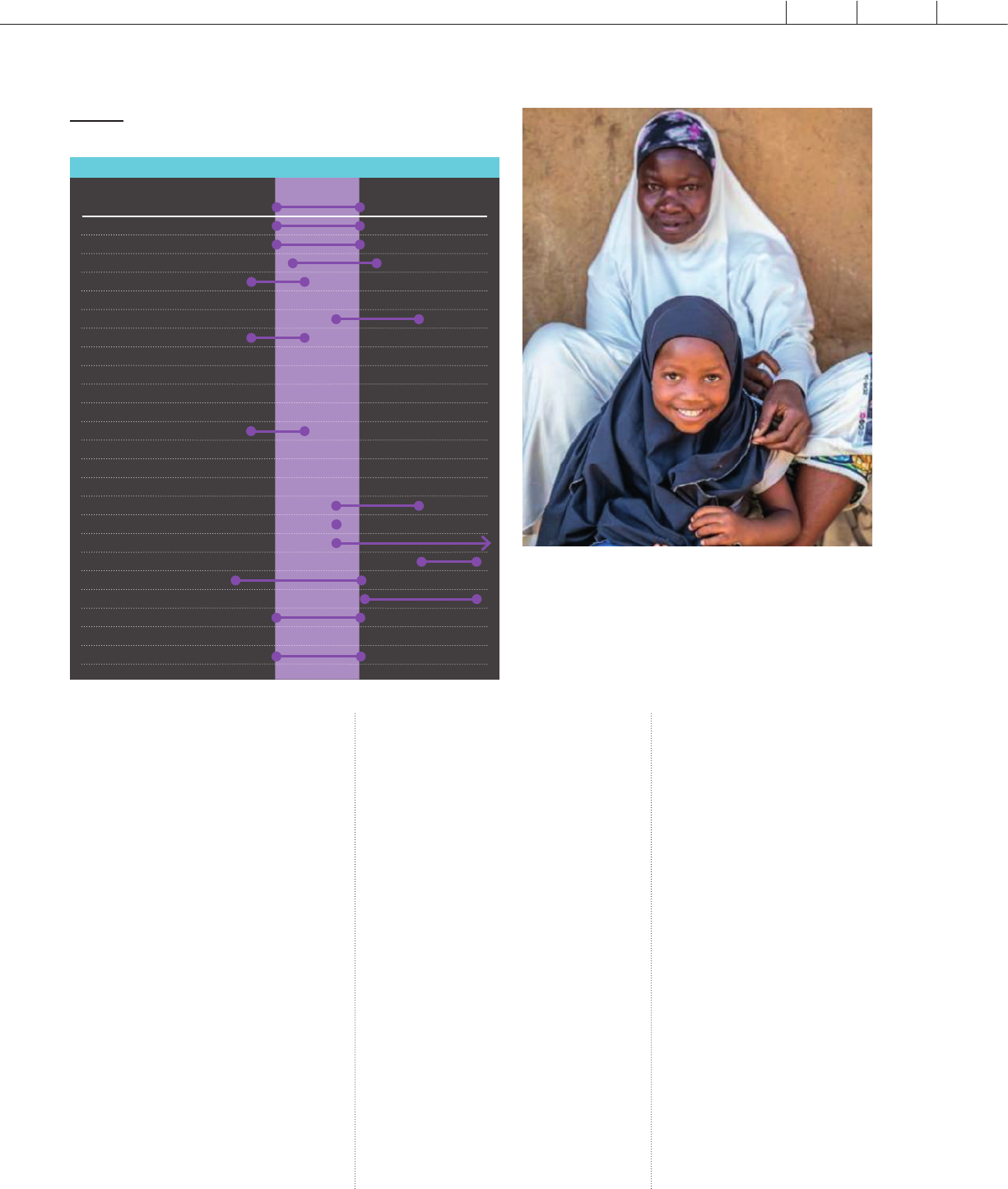
ECOWAS is currently developing a
certification project to identify products
that comply with its norms. However,
salt is presently not part of this project.
Combining this regional certification
system with innovative technology such
as blockchain technology could help salt
producers obtain iodine levels and salt
quality certification. The certificate can be
verified along the supply chain, assuring
salt buyers that the salt has been approved.
This could minimise the need to assess the
salt at each border.
In summary, most WCA countries
import iodised salt to meet their national
salt requirements, and the region can meet
these needs. However, the intra-regional
trade of salt is below its potential. The-
refore, a more in-depth assessment of the
trade barriers and facilitators is needed to
design and implement policies to promote
intra-regional trade, identify trade facilita-
tion initiatives and support the value chain
development of iodised salt (9).
Improving the intra-regional trade will
contribute to the regional economy and
could improve the supply and demand
of iodised salt both for salt-producing
countries and salt-importing countries due
to the symbiotic relationship between the
countries.
References
1. Ibitoye O. Assessment of the potential level of
food trade in the ECOWAS region. 2020;18.
2. UN Comtrade | International Trade Statistics
Database [Internet]. [cited 2022 May 14]. Available
from: https://comtrade.un.org/
3. Nigeria | Imports and Exports | World | Salt;
sulphur; earths and stone; plastering materials, lime
and cement | Value (US$) and Value Growth, YoY
(%) | 2008 - 2020 [Internet]. 2021 [cited 2022
May 14]. Available from: https://trendeconomy.com/
data/h2/Nigeria/25
4. Torres C. Overview of trade and barriers to trade
in West Africa. 2016;(195):94.
5. Ibitoye O, Ibitoye AL. Determinants of intra–ECO-
WAS regional food trade: An augmented gravity
model approach. 2020;18.
6. Were M. Differential effects of trade on economic
growth and investment: A cross-country empirical
investigation. JAT. 2015;2(1–2):71.
7. Non-tariff barriers [Internet]. The Institute for
Government. 2017 [cited 2022 May 14]. Available
from: https://www.instituteforgovernment.org.uk/
explainers/non-tariff-barriers
8. Hummels DL, Schaur G. Time as a Trade
Barrier. American Economic Review. 2013 Dec
1;103(7):2935–59.
9. Hoekman B, Shepherd B. Who profits from
trade facilitation initiatives? Implications for African
countries. JAT. 2015;2(1–2):51.
10. Grant F, Tsang BL, Garrett GS. Food Fortification
in West Africa. SAL 2018. 2018;
IDD NEWSLETTER MAY 2022 SALT TRADE
13
FIGURE 3
Comparison of iodine levels for imported salt by
country in West and Central Africa
Countries Import iodine level (ppm)
10 20 30 40 50 60 70 80 90 100
ECOAW and UEMOA
Benin
Burkina Faso
Cameroon
Cabo Verde
Central African Republic
Chad
Republic of Congo
Côte d'Ivoire
Dem. Rep. of Congo
Equatorial Guinea
Gabon
Gambia
Ghana
Guinea
Guinea Bissau
Liberia
Mali
Mauritania
Niger
Nigeria
Sao Tome y Principe
Senegal
Sierra Leone
Togo
© UNICEF/UN0376940/Esiebo
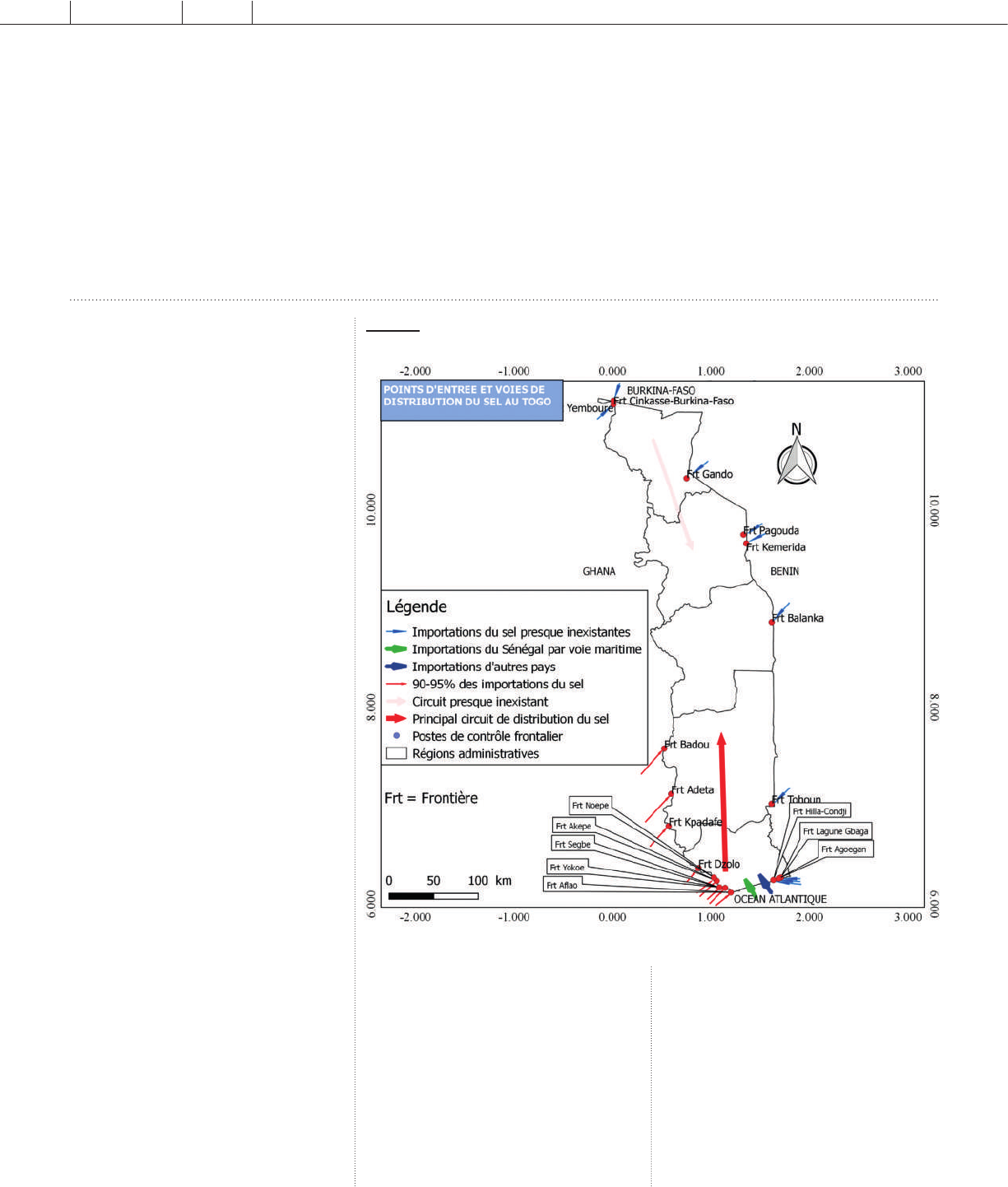
Lessons from Togo on sustainable
USI
Dédényo Adossi, Consultant, Iodine Global Network; Mamatchi Mélila, Lecturer, Université de Lomé; Komlan Kwadjode, Nutrition specialist, UNICEF Togo;
Mouawiyatou Bouraima, Head of Nutrition Division, Ministry of Public Health and Hygiene
Togo, a francophone country located on
the Gulf of Guinea, does not produce
sufficient salt but imports it mainly from
neighboring Ghana. The first national sur-
vey on the situation of iodine deficiency
was carried out between 1982 and 1986,
and showed a goiter prevalence of 18%
among the Togolese population (1). This
alarming rate prompted the generalized
distribution of iodized oil in the period
1990-95 to prevent Iodine Deficiency
Disorder (IDD). National legislation on
universal salt iodization (USI) was adopted
in 1996 (Arrêté interministériel N°76/
MSP/MCPT, 1991), and updated in 2017
(Arrêté N°124/2017/MSPS/MCPS/
MEPSFP/MEF ) to comply with the new
Economic Community of West African
States (ECOWAS) standards. Results of
the USI program until 2005 were remar-
kable, thanks to consistent funding, strong
multisectoral coordination and leadership
by the Ministry of Health. In just ten ye-
ars the household coverage of iodized salt,
which was almost nonexistent in 1995 (at
1%), was universal by 2005 (at 92%) (2,3).
Consequently, the median urinary
iodine concentration (mUIC) measured
through a national survey in 2005, re-
vealed a mUIC of 171,4μg/l in schoold
age children, which is considered to be
in the adequate range (2). Unfortunately,
this is the only existing data on iodine
status and no survey has taken place since.
As of 2005 the situation started to reverse.
Following a fall in financing by partners,
monitoring and sensitization activities
became more difficult to maintain. This
proved a barrier to the sustainability of the
program, and there was a steady decline in
the general trend of household coverage
of iodised salt, which decreased to 81% in
2010 and 63% in 2017 (4,5).
A stocktaking exercise undertaken by the
Nutrition Division in 2013 showed a lack
of surveillance of salt iodization at borders
and the necessity to clarify roles and
responsibilities of different stakeholders
(6). This prompted the development of
guidelines for the surveillance of iodized
salt, the supply of portable WYD spectro-
meters for the quantitative assessment of
iodine in salt at the border and of labora-
tory equipment for the national reference
laboratory (6).
14
IDD NEWSLETTER MAY 2022 TOGO
FIGURE 1
Location and distribution of the main salt import and distribution routes
in Togo (7)

IDD NEWSLETTER MAY 2022 TOGO
15
However, these efforts were not sustained,
the WYD spectrometers was provided to
official entry points only, while there is
illegal entry of salt via the multiple dirt
roads along the 600 KM border with
Ghana (7) (see figure 1). Furthermore,
when controls were conducted, their
results were not necessarily used by the
decision makers and leaders of the USI
program.
In 2021, as part of the IGN/UNI-
CEF regional partnership, a situational
analysis of the iodization program in Togo
was conducted together with the Govern-
ment to understand the low availability of
iodized salt in the savanna regions. The
study included 21 importers/wholesalers
and 61 retailers in the markets as well as
the collection of 82 samples of cooking
salt. Findings show that more than one
in two respondent (58%) does not know
about the legislation on salt iodization.
For 20% of retailers, color was the quality
criterion for iodized salt, while for whole-
salers, color (18%), price and iodine con-
tent (18%) were the determining factors.
Iodine content was important only for
7% of retailers and 4.5% of wholesalers.
A staggering nine in ten (93%) retailer
and one in two wholesaler (54%) does
not control the quality of salt, including
iodine level, before purchase.
Retailers declare that 43.3% of
purchased salt is iodized, while it reaches
56.7% for wholesalers, the adequacy of
the iodine level was not possible as only
qualitative assessments were possible at
the purchase sites. However, the overall
mean iodine content of all samples (up
to 12.94 ppm) was below requirements
(of at least 20 ppm in Togo). Labelling is
unreliable as salt is repackaged by 83% of
respondents. The main conclusions of the
situation analysis show that to revita-
lize the USI program in Togo, driving
demand for iodized salt while ensuring
the supply of quality imported iodized
salt by importers and its control at borders
will be instrumental. Continuation of
sensitization of all stakeholders will also be
necessary to ensure adequate household
coverage of iodized salt.
From the Togolese experience, it is
clear that the sustainable success of the
USI program can be highly dependent
on synergy between the different sectors
involved. A dedicated domestic budget
line will help avoid dependence on fun-
ding from partners. Effective monitoring
associated with actions are essential and
there must be strong linkage between the
USI coordinating team and the importers.
These are important elements to consider
in developing and implementing a suc-
cessful sustainable USI strategy.
References
1. Doh A, Adjaka Y, Quashie K, Francois C, Ame-
la S, Agbe A, et al. Document national du Togo
prepare pour la Conférence Internationale sur la
Nutrition: Rome. In Rome; 1992. p. 37.
2. Ministère de la santé. Evaluation de la lutte
contre les troubles dus a la carence en iodie en
2005 au Togo. 2006.
3. Ministère Du Plan et de l’Aménagement du
Territoire, UNICEF. Enquête Nationale sur la
Situation des Enfants au Togo en 1995 (MICS-
Togo-96). 1996.
4. Ministère auprès du Président de la Républi-
que, chargé de la Planification, du Développe-
ment et de l’Aménagement du Territoire, Direction
Générale de la Statistique et de la Comptabilité
Nationale, UNICEF. Togo - Suivi de la situation
des Enquête par grappes à indicateurs multiples
enfants et des femmes. 2010.
5. Institut National de la Statistique et des Etudes
Economiques et Démographiques (INSEED),
UNICEF. TOGO MICS6 - Enquête par grappes à
indicateurs multiples 2017. 2019.
6. Ministère de la santé. Guide de contrôle de
qualité du sel alimentaire au Togo. 2013.
7. Adossi D. Etude du système de distribution
et de contrôle du sel iode au Togo. Institut poly-
technique LaSalle Beauvais (France); 2015.
© UNICEF/UN0428853/Tremeau
© UNICEF/UNI282238/Pudlowski
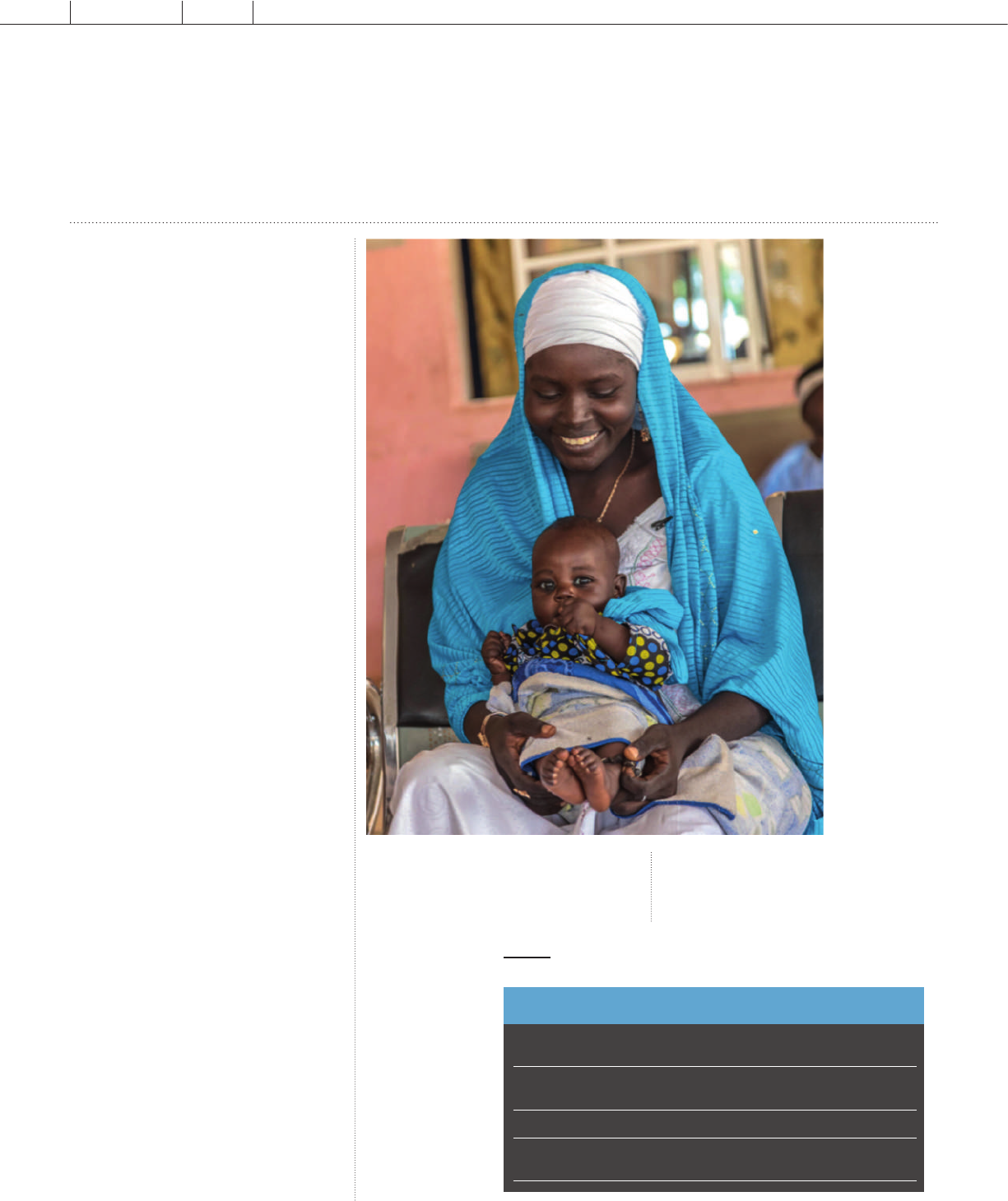
16
IDD NEWSLETTER MAY 2022 NIGERIA
Salt value chain analysis in Nigeria
Introduction
Numerous studies have clearly establis-
hed that fortification of salt with iodine is
an effective means of controlling iodine
deficiency. Since the effective introduc-
tion of salt iodization in Nigeria in 1993,
the sustained salt iodization program
has ensured an adequate iodine status
among the whole the population. Nigeria
achieved global recognition in 2007 as
the first African country to be compliant
with universal salt iodization (USI) due
to sustained high levels of salt iodization
coverage (from a level of <40% in 1993)
to 95% or higher. Despite the reference to
salt for food processing in the original de-
finition of universal salt iodization (USI),
Nigeria’s USI program does not explicitly
address food industry salt. This may affect
program impact and sustainability, given
the increasing consumption of processed
foods triggered by higher income, urbani-
zation, and lifestyle changes. This affects
the source of salt and potentially iodized
salt among the population. It is against
this backdrop that a salt value chain ana-
lysis was conducted. It had as objective:
(a) assessment of the contribution of salt
contained in industrially processed foods
to salt and iodized salt consumption of the
population; and (b) to identify the pos-
sibilities of expanding the salt iodization
strategy to include processed foods.
Methodology
The methods used include a review of
reports and other documents and key
informant interviews (KII). Documents
that were reviewed include government
agency and partners’ reports on the salt si-
tuation. Structured face-to-face interviews
with food manufacturers and in-depth in-
terviews with processed food wholesalers
and retailers were conducted and food
labels were checked in the supermarkets
and local markets.
Key findings
Even though Nigeria has large salt depo-
sits in some states including Benue, Cross
River, Ebonyi, Abia, Taraba and Nasara-
wa states, there is no large-scale mining
of these salt deposits. As such, most salt
manufacturers import salt from Brazil,
Namibia, South Africa, China, Australia,
India and the USA. Nigeria’s imported
salt worth increased from N4.5bn to
N4.8bn (1). Nigeria imports from Brazil
were estimated at US$33.79 million
during 2019 (2).
Wasiu A. Afolabi, Professor, Federal University of Agriculture, Abeokuta, Ogun State, Nigeria; Francis T. Aminu, Aliko Dangote Foundation, Lagos, Nigeria
TABLE 1
Manufacturers, Marketers and Distributors of Salt
in Nigeria
Name of Production Product Domestic Export
Industry Capacity Market Market
NASCON 2450MT/Day Table Salt Nigeria Benin
Industrial Salt
Royal Salt 300,000MT Table Salt Nigeria
Industrial Salt
Mr Chef N/A Table Salt Nigeria
JOF Salt 108,000 Industrial Salt Nigeria Ghana
MT/Month
© UNICEF/UN0377181/Esie
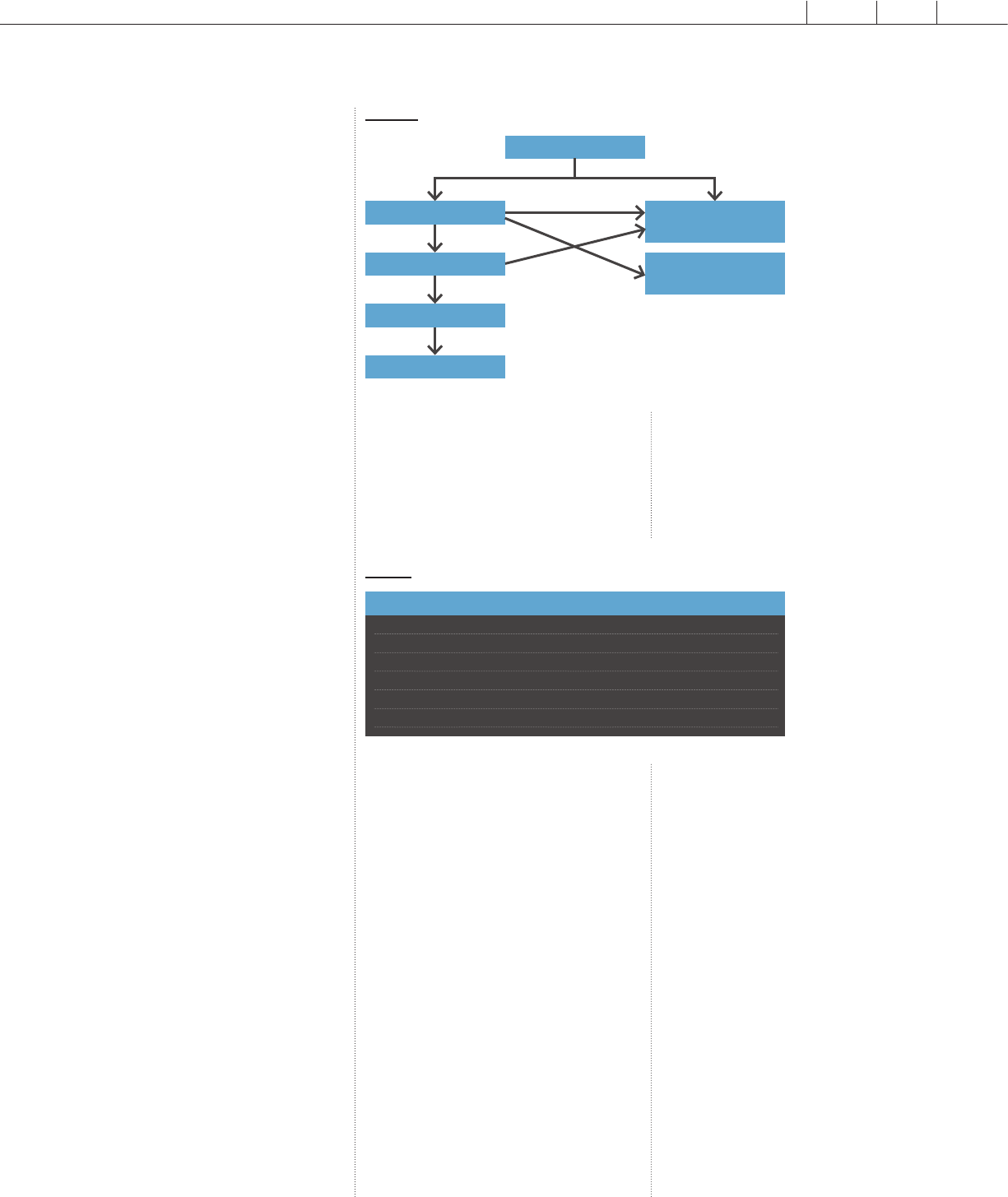
IDD NEWSLETTER MAY 2022 NIGERIA
17
Raw salt is imported by major salt manuf-
acturers from Brazil, Australia, Tunisia,
and Namibia. All salt imported from
Brazil, Tunisia and Namibia is not iodized
and so it is the responsibility of the repa-
ckaging companies to fortify imported salt
with iodine before selling to the consu-
mers. Countries of export for salt from
Nigeria include Benin Republic, Niger
Republic, Cameroon, Ghana, and Chad.
All food grade salt produced for domestic
use and export is iodized.
There are three major salt manufactu-
rers producing salt in Nigeria for com-
mercial purposes (Dangote Salt, Royal
Salt, and Mr. Chef Salt) and one that pro-
duces salt for food industries (JOF) (Table
1). Dangote and Royal Salt produce table
salt and industrial salt while Mr. Chef only
produces table salt. JOF salt, at the time
of the assessment, did not have salt in the
open market but only produced industrial
salt that was supplied to food companies
for cornflakes, bouillon, and seasoning
production, with Nestle Foods as a major
client.
There are two major channels of
salt distribution in Nigeria. One is direct
from the factory to the large consumers,
such as the food processing industries and
livestock farms. The second channel is
from the factory to major distributors or
wholesalers who also sell to retailers and
who in turn sell to consumers. Interestin-
gly, medium- and small-scale industries as
well as fisheries and livestock farms also
procure salt from major distributors and
subdistributors. As shown in Figure 1, salt
is procured from the factory by major
distributors who are often referred to as
dealers who move the supplies to their
warehouses and outlets. Subdistributors
and wholesalers also procure from the ma-
jor distributors for display in their stores/
shops. At times they supply directly to
their clients on request. Retailers procure
salt from subdistributors or distributors
and then sell to the consumers. Distribu-
tors and subdistributors at times supply salt
directly to food processing companies and
fishery and livestock farm.
The survey indicates that food pro-
cessing companies, wholesale distributors
and marketers are the major consumer of
salt from the industries. As shown in Table
2, food processing companies procure
about 26% of the salt. Wholesale distri-
butors also constitute about 26% of the
salt consumers while supermarket/mall,
retailers and livestock farms were less than
20% each. Supermarkets, malls, and stores
are the major salt procurement clients,
followed by fisheries and livestock farms.
Iodized salt constitutes about 99% of
the salt in the market while non-iodized
salt is about 1% and are not displayed
openly for sale. Dangote Salt (50kg) sold
for N4400 - N5000 while Royal Salt
(50kg) sold for N4300 - N4900. The
salt procurement capacity of distributors
and marketers of salt varies, and ranges
between 1000 and 50,000 bags for a range
of 1 to 6 times per month. The majority
(70%) of the distributors and marketers
procure less than 5000 bags while others
constitute 10% each. Dangote Salt, Mr.
Chef Salt and Royal Salt continue to do-
minate the market in Nigeria as they were
ranked first, second and third, respectively
(Table 3). Although, clients in Lagos ran-
ked Mr. Chef salt first and Dangote Salt
second, indicating that ranking of salt is
location specific.
The major consumers of salt in Nige-
ria are food processing industries, super-
markets and malls, wholesale distributors,
retailers, and livestock industries (Table 4).
For table salt, the domestic market for the
product can be found in all local markets,
supermarkets, and shopping malls while
the export market is in Benin Republic.
For industrial salt, the local market
includes soap manufacturers, seasoning
companies, noodle producers, margarine
producers and animal feed manufacturers.
FIGURE 1
Salt distribution channel
Salt Factory
Major Distributors
Sub Distributor
Retailer
Consumer
Food processing
Companies
Fishery and Live-
stock Farms
TABLE 2
Major Consumers of Salt (Survey 2021)
Name Frequency (n) Percentages (%)
Food Processing Industries 10 25.6
Pharmaceuticals 0 0
Supermarket/Mall 7 17.9
Wholesale Distributors 10 25.7
Retailers 6 15.4
Livestock 6 15.4
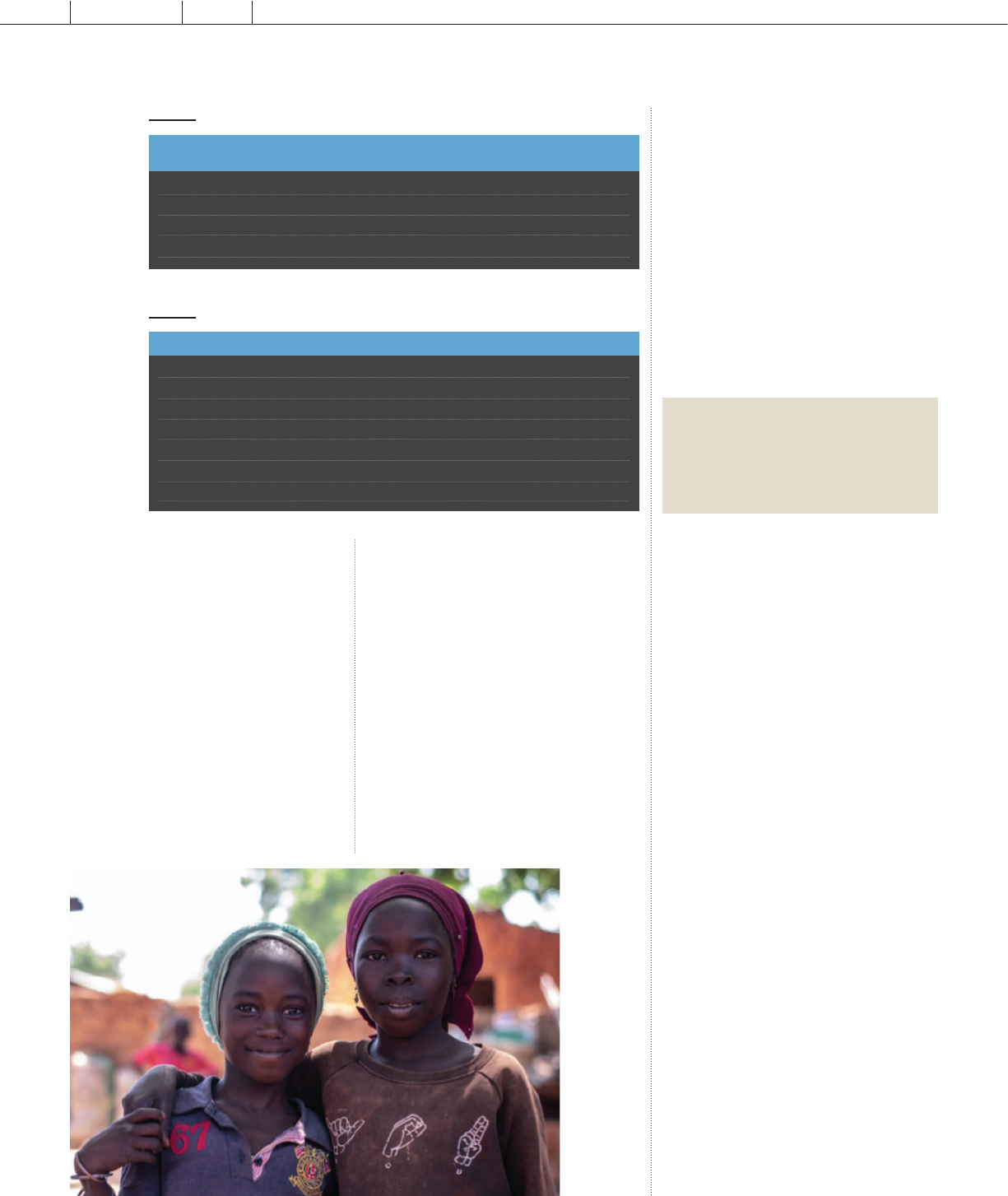
Conclusion
Although food grade salt is being produ-
ced by four salt manufacturers in Nige-
ria, there is a need for adequate policy
to address fortification compliance and
fluctuation in price. Challenges faced by
marketers and distributors ranges from
high pricing, untimely delivery by the
manufacturers and logistics problems. The
Standard Organization of Nigeria (SON)
and the National Agency for Food, Drug
Administration and Control (NAFDAC)
are the agencies involved in the monito-
ring of salt business in the major salt mar-
kets. Salt distribution follows two major
channels; from factory to major distribu-
tors who procure salt from factories and
supply either directly to food processing
companies and or Sub- distributors and
wholesalers who supply to retailers and
then finally to consumers.
The analysis also revealed that some
factories also supply direct to food pro-
cessing companies indicating that food
processing companies, wholesale distribu-
tors and marketers are the major con-
sumers of salt while supermarkets, malls
and stores are the major salt procurement
clients, followed by Fisheries and livestock
farms. Various industries that procure salt,
cut across cosmetics industries, Biscuits
and sweet industries, hotels, kitchen and
restaurant, bread and bakery industries,
supermarkets, malls and stores and fishe-
ries and livestock farms. There is a need
to encourage more salt manufacturers in
the market to increase competition, ade-
quate monitoring of industries to ensure
compliance and regulate price of salt to
prevent fluctuation. However, the con-
tribution of industrially processed foods
to salt and iodine intake and the possible
impact of salt reduction on iodized salt in-
take remain to be quantified. To improve
Nigerian USI programs, further data are
required on processed food consumption
across population groups, iodine contents
of food products, and the contribution of
processed foods to iodine nutrition.
References
1. National Bureau of Statistics (NBS), UNICEF,
and UNFPA (2013), Nigeria Multiple Indicator
Cluster Survey (MICS) 2011
2. United Nations COMTRADE ( 2021) https://
tradingeconomics.com/nigeria/imports/brazil/salt-
including-table-dentrd-pure-sodium-chloride
TABLE 3
Salt Ranking by Marketers and Distributors (Survey 2021)
Salt Product 1st % 2nd % 3rd %
(n) (n) (n)
Dangote Salt 7 70 3 30 – –
MR. Cheff Salt 3 30 3 30 4 40
Royal Salt – – 4 40 4 40
Total 10 100 10 100 8 100
TABLE 4
Large Scale Salt Procurement Clients (Survey 2021)
Name Frequency (n) Percentage (%)
Cosmetics Industries 1 2.5
Biscuit and Sweet Industries 2 5
Kitchen and Restaurant 8 20
Hotels 2 5
Bread and Bakery Industries 6 15
Supermarkets, Malls and Stores 12 30
Fisheries and Livestock Farms 9 22.5
© UNICEF/UN0396203/Owoicho
18
IDD NEWSLETTER MAY 2022 NIGERIA
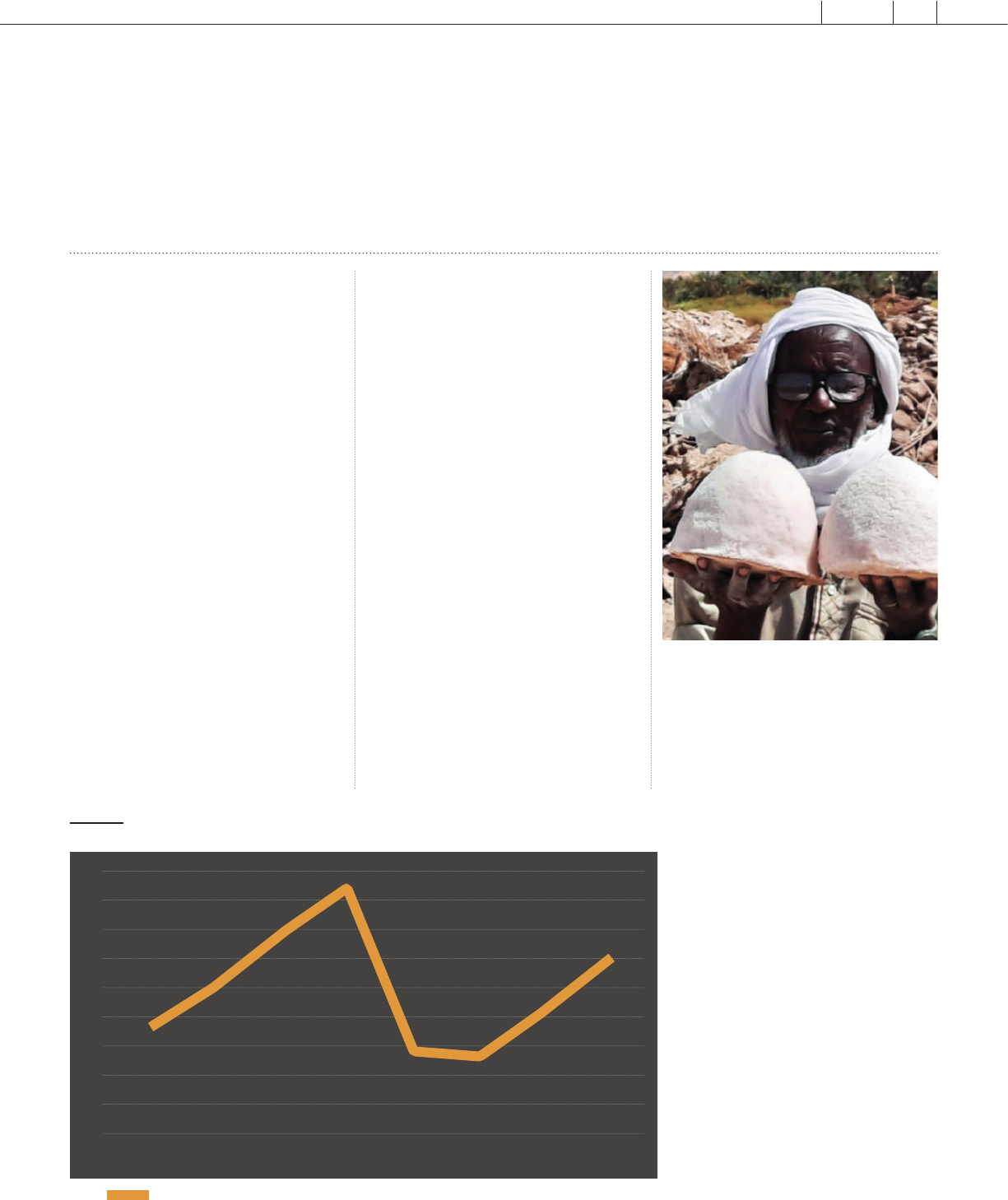
IDD NEWSLETTER MAY 2022 CHAD
19
Salt iodization in Chad
Chad is a landlocked country and almost
all salt consumed is imported from
Cameroon, Egypt, Libya and/or Sudan
with small artisanal salt producers in the
northern part of the country. A national
survey conducted in 1994 showed a goiter
prevalence of 63% and that 1% of the po-
pulation was affected by cretinism. Iodine
deficiency was hence declared a public
health issue and iodization of salt for hu-
man and animal use was made mandatory.
However, the lack of financial means has
impeded the application of legislation.
With the declaration of iodine deficiency
as a public health issue in 1994, legislati-
on was put in place, defining the level of
iodization, monitoring, and surveillance
of household salt. Iodization is mandatory
for all salt for human and animal con-
sumption, but since the legislation does
not specifically mention locally produced
salt and salt for export, many erroneous-
ly believe these salts do not need to be
iodized.
Universal Salt Iodization was
integrated in several national nutrition
policies and plans. Decisions related to
iodine nutrition are deliberated at the
level of the National Council of Food
and Nutrition which meets once a quarter
and implemented by the executive body,
the Permanent Technical Committee on
Nutrition and Food, which is housed in
the National Directorate of Nutrition and
Food Technology (DNTA). The DNTA
is an organ of the Ministry of Public
Health and National Solidarity, who
oversees the coordination, follow-up, and
monitoring of iodine nutrition actions.
The demographic and health surveys,
as well as the SMART surveys underta-
ken in the country since 2000 show an
upward trend for the period 2000-2014,
when the use of household iodized salt
increased from 58% in 2000 to 82%. This
had direct consequences on the iodine
status of the population. The latest data
on iodine status dates to 2003 and showed
that school aged children (aged 6-12
years) had an adequate iodine status, with
a mUIC of 213μg/L. Between 2014 and
2019 there was a sharp fall in the use of
iodized salt, down to 65%, before it slow-
ly went up again, to reach 70% in 2021
(Figure 1).
An iodized salt evaluation mission
conducted in 2014, shows that salt from
Cameroon and Egypt transiting through
Cameroon was correctly iodized, while
salt imported from Sudan or locally pro-
duced was either poorly iodized or not
iodized at all. Recent surveys have
found little variation in access to io-
dized salt by urban/rural but did find
variation by region due to the origin
of the salt. For example, in the East,
the salt comes from Sudan, where it
is not iodized, leading to low use of
iodized salt in this region. The 2019
MICS did show differences per wealth
quintile, with the richest households
more likely to use adequately iodized
salt. Domestic production of non-
iodized salt is growing significantly in
the provinces of Borkou, Ennedi and
Tibesti, but unfortunately no action is
undertaken to ensure compliance with
the country's salt iodization legislation.
While the general population has
some level of awareness of the im-
portance of iodized salt, there is some
confusion as some bags of salt are
Sansan Dimanche, International Nutrition Consulting (INC-Tchad); Viviane Djoret, UNICEF Chad; Mahamat Abdelkerim, Nutrition and Food Technology
Directorate (MOH, Chad);
Djibril Cisse, UNICEF Chad
FIGURE 1
Availability of iodized salt at household level through different surveys
in Chad
85
80
75
70
65
60
55
50
45
40
MICS
2000
DHS
2004
MICS
2010
DHS
2014
SMART
2017
SMART
2019
SMART
2020
SMART
2021
58
Salt iodization
65
74
82
53.5
52.7
53.5
60.7
69.8
Clumps of non-iodized salt from Boudo
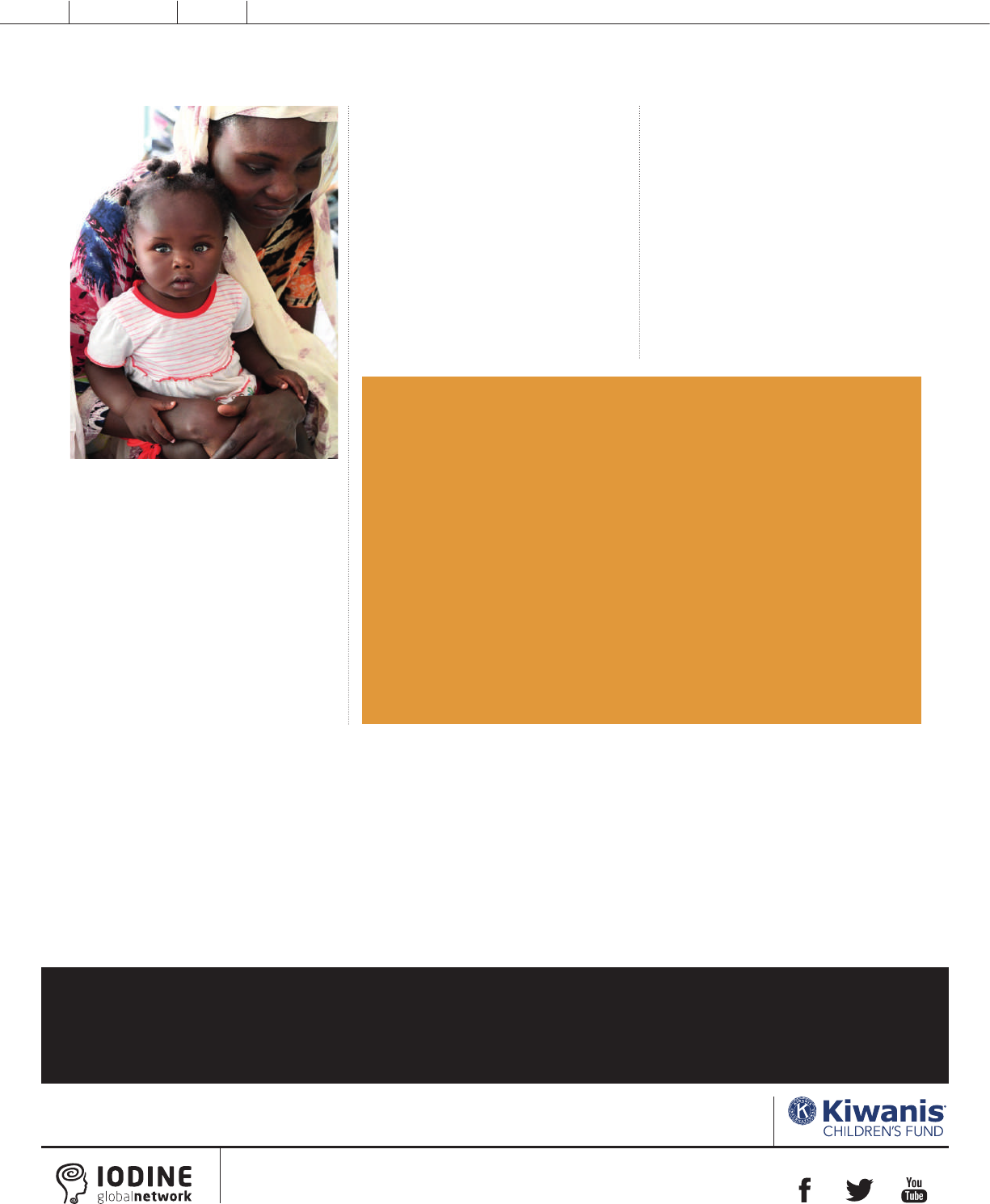
Iodized salt for a bright future for children in
Chad
History of the salt trade in Chad
Local production and salt trade has been linked to caravanners, who would
insure the transport of salt across long distances. The entire salt route was
controlled by the Gorane and Toubou populations, who owned camel herds,
and would drive the large caravans. At the time of independence, the Gover-
nment tried to formalize the exploitation of salt mines but without success,
and the artisanal production of salt has continued to this day.
Different types of salts are produced in the country and in different
forms such as rock salt, sometimes called halite, whose formation dates back
millions of years. It is the remains of the Paleo-Chadian sea that disappeared
several thousand years ago, leaving giant underground reservoirs at a depth
of several hundred meters, also called salt domes.
The two main local rock salt production sites in Chad include the Bou-
do site, which is an open-pit salt mine, and the Dimé (Dyi) site. The latter is
a group of about fifty lakes, remnants of a larger lake that occupied the ba-
sin, supporting a wide diversity of aquatic habitats, vegetation, and wetlands,
as well as highly contrasting salinity, ranging from freshwater to hyper-saline.
20
IDD NEWSLETTER MAY 2022 CHAD
THE IDD NEWSLETTER
is published quarterly by the Iodine Global Network and distributed free of charge in bulk by international agencies and by
individual mailing. The Newsletter is also distributed to email subscribers and appears on the Iodine Global Network’s website (www.ign.org). The Newsletter
welcomes comments, new information, and relevant articles on all aspects of iodine nutrition, as well as human interest stories on IDD elimination in countries.
For further details about the IDD Newsletter, please contact: Michael B. Zimmermann, M.D., the editor of the Newsletter, at the Human Nutrition Laboratory,
Swiss Federal Institute of Technology Zürich, [email protected].
The Iodine Global Network gratefully acknowledges the support of Kiwanis Children's Fund, Indianapolis, USA,
and the Swiss Federal Institute of Technology Zürich for the IDD Newsletter.
www.ign.org
© Copyright 2022 by the Iodine Global Network
Design: www.imholzdesign.ch
Print: www.spaeltidruck.ch
falsely labelled as iodized and charged at
a higher price than non-iodized salt from
Sudan. Through the community health
agent network who promote optimal
maternal nutrition and infant and young
child feeding practices, control of salt
iodization is promoted at household and
community level, using the UNICEF
provided iodine tester kits.
Following the 2021 situation analysis,
the resulting roadmap for strengthening
the salt iodization program (2022-2025)
offers promising prospects in revitalizing
the USI program. The first axis of the
roadmap focuses on the legislative aspect
of USI and aims to ensure knowledge and
application of regulatory texts, including
on local production, and improve acces-
sibility of iodized salt and its control. The
operational axis of the roadmap will aim
to train all USI stakeholders and develop
a communication strategy on salt iodiza-
tion coupled with the reduction of salt
consumption. The last axis will evolve
around a feasibility study on domestic
salt production, support to salt producers
and the establishment of a coordination
structure to promote iodized salt.
